Few design eras feel as free-spirited — or as surprisingly adaptable — as the 1970s. Saturated earth tones, tactile finishes, and a dash of playful futurism turned the decade’s dining spaces into lively hubs for conversation, music, and experimental cooking. Today, those same hallmarks translate into cozy authenticity rather than kitsch, letting you layer retro charm over modern layouts without sacrificing comfort or everyday practicality. Whether you lean boho with rattan and jungle greenery or prefer the sleek confidence of pedestal tables and chrome, a 70s dining room can flex to fit city apartments, suburban remodels, or airy lofts. Ready to channel that groovy energy? Let’s dive in.
1. Sunburst Mirrors Amplify Warmth in a 70s Dining Room
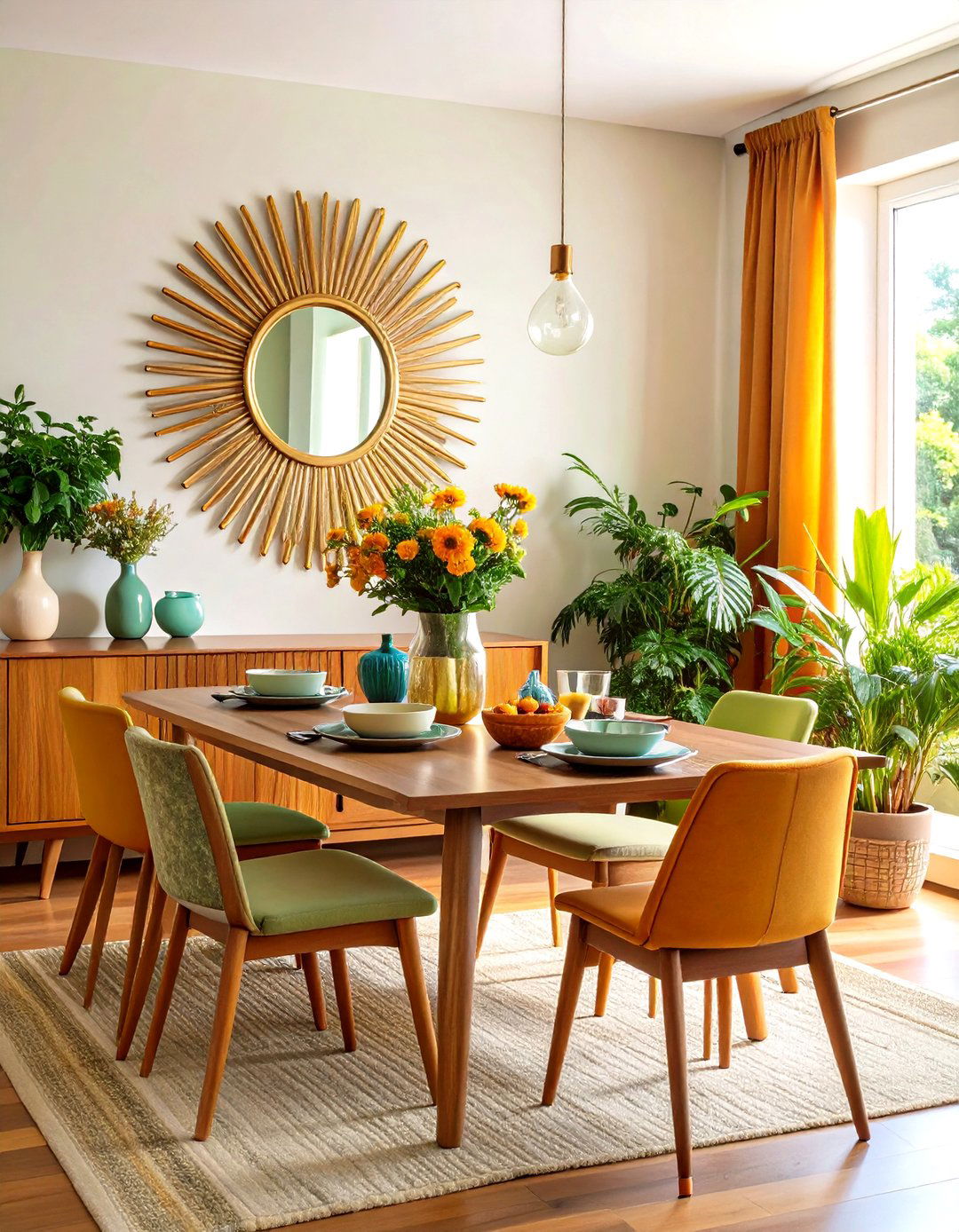
A radiant sunburst mirror instantly sets the mood, framing your 70s dining room with optimism and light. The iconic spiky rays — often in brass, teak, or resin — echo the decade’s fascination with space-age motifs while bouncing daylight deeper into the space. Position one above a sideboard so its reflections capture colorful dinnerware and greenery, doubling the visual footprint. For practicality, choose a diameter scaled to your wall: a 24- to 36-inch piece typically balances standard dining proportions. Pair the mirror with matte walls so its metallic or wooden finish stands out, creating a focal point that feels celebratory rather than overwhelming.
2. The Tulip Pedestal Table Clears Visual Clutter

The instantly recognizable tulip pedestal table, popularized by designer Eero Saarinen, lends your 70s dining room a sleek, almost sculptural presence. Its single flared base frees up leg space and keeps chairs from tangling with table legs — a functional win in tight rooms. Opt for a white lacquer, faux marble, or walnut-veneer top to echo the era, then surround it with molded plastic or velvet-upholstered seats for textural contrast. Because the table’s round shape promotes conversational flow, it also encourages lingering mealtime chats. A vintage reproduction retains authenticity without the collector’s price tag, while modern reissues stay true to the original silhouette.
3. Rattan and Wicker Seating Adds Breezy Texture
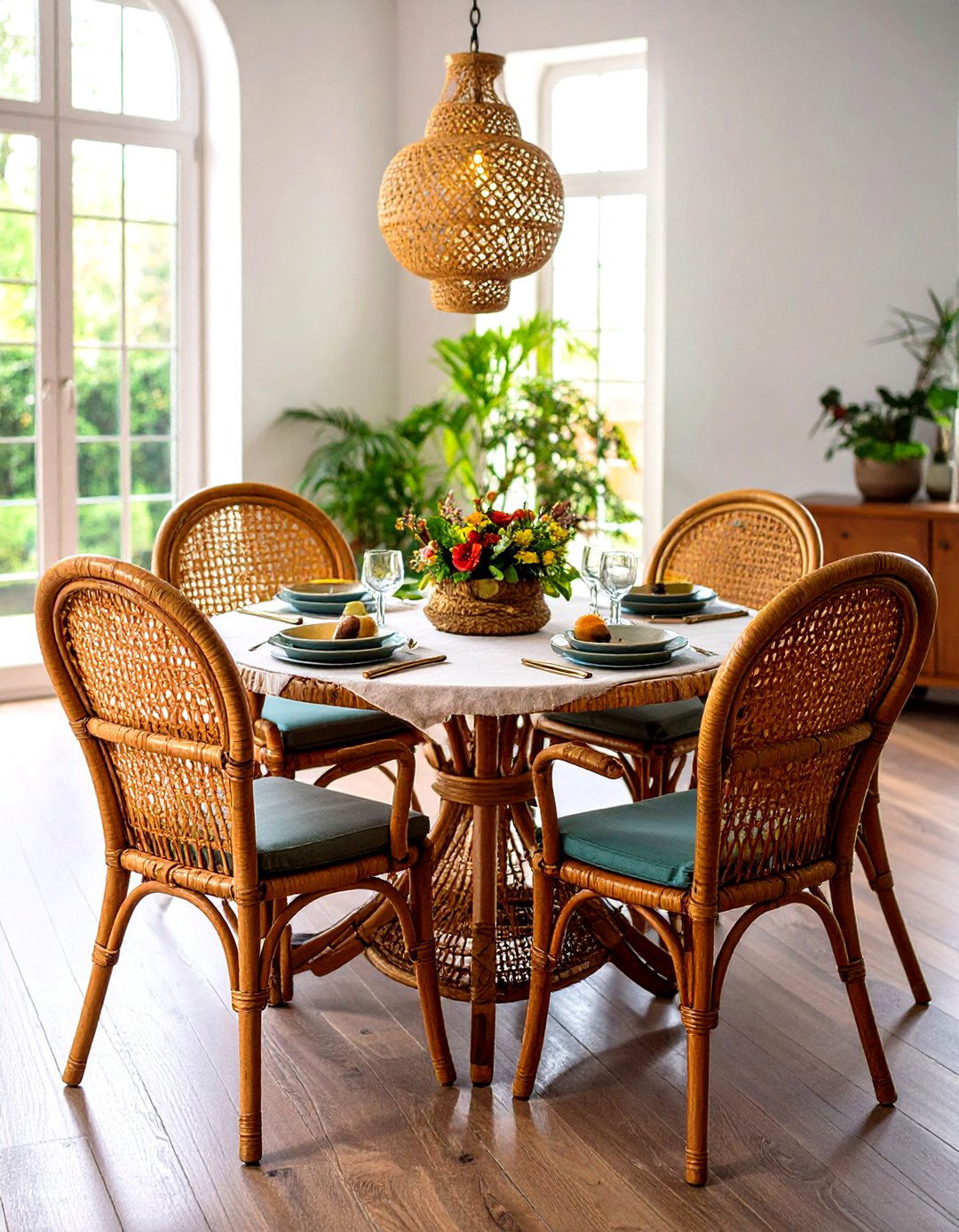
Nothing says laid-back 1970s like a set of rattan armchairs wrapping around your 70s dining room table. The tightly coiled cane curves soften angular architecture and introduce a resort vibe that still feels breezy in 2025 apartments. Look for high-back peacock chairs for drama or simple caned seats for subtlety, mixing them with upholstered host chairs if you crave extra comfort. Rattan’s honey tone harmonizes with avocado green, harvest gold, and terracotta paint — core palettes of the era. Treat each chair with a UV-protectant varnish to minimize fading, and slide felt pads under the legs to prevent scratches on wood floors.
4. Psychedelic Wallpaper Turns Walls into Art
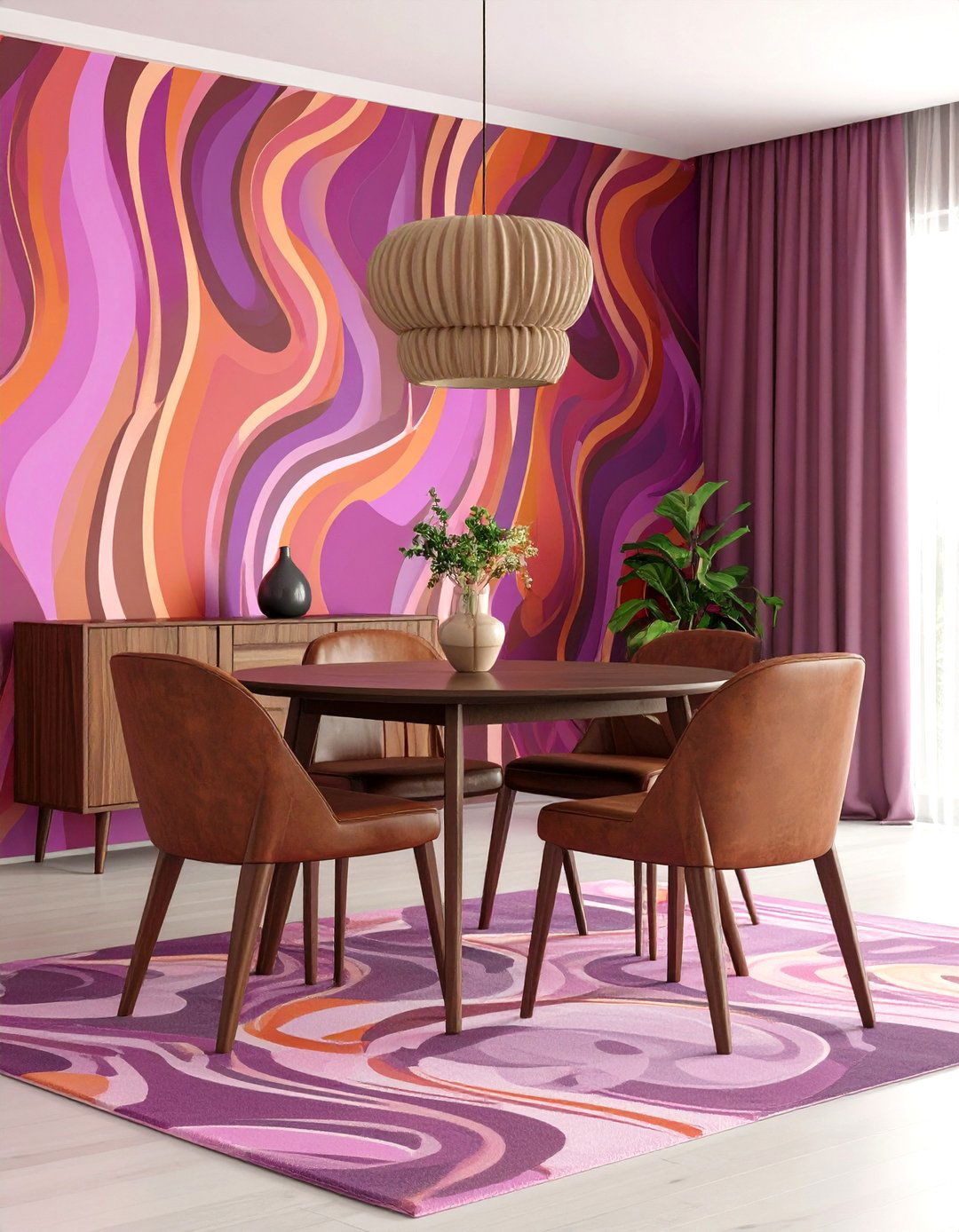
Unlike timid accent walls, a full-room swath of psychedelic wallpaper transforms a 70s dining room into an energetic time capsule. Swirl patterns in magenta and tangerine or geometric waves in chocolate and cream provide instant character, eliminating the need for extra artwork. Balance the busy print by choosing sleek, low-profile furniture so the pattern remains hero. Peel-and-stick modern papers offer easy install and removal, making this bold move renter-friendly. For small spaces, cover just the ceiling to conjure a cozy “dining tent” effect without overwhelming sightlines. The result is an immersive backdrop that sparks conversation with every meal.
5. Macramé Plant Hangers Bring the Outdoors In
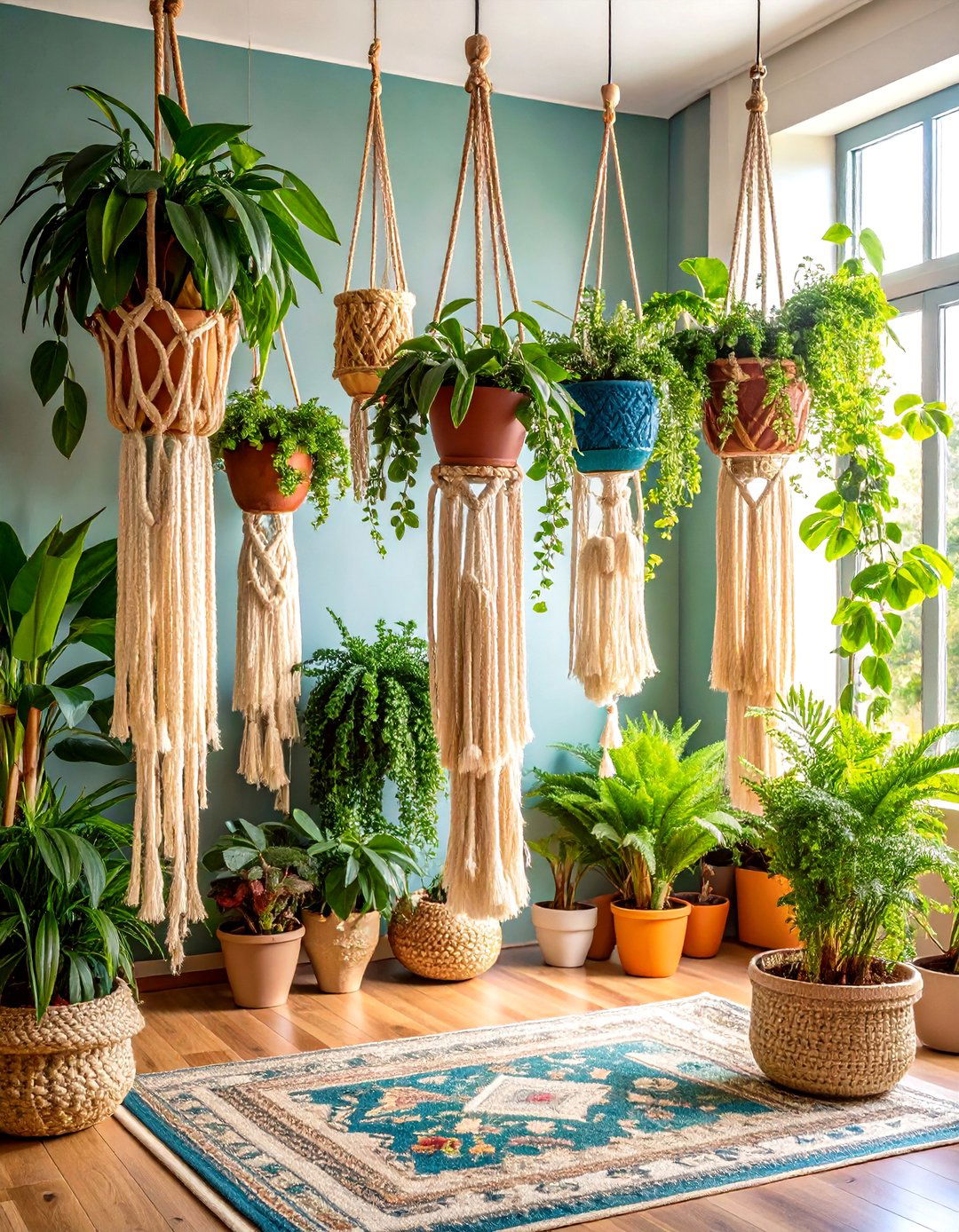
As houseplant fever swept through the 1970s, macramé hangers became must-have décor — an easy DIY you can replicate today. Suspend a trio of pothos or trailing philodendrons at staggered heights over the 70s dining room corner to soften hard edges and purify the air. Natural cotton rope complements rattan, while dip-dyed versions add a pop of retro color. Drill safe ceiling anchors or use tension rods in rentals, and be sure drip trays are snug to protect flooring. The gently swaying greenery bridges eras, turning mealtime into a mini-escape that feels organic, bohemian, and refreshingly low-maintenance.
6. Earthy Palettes Wrap the Room in Cozy Nostalgia
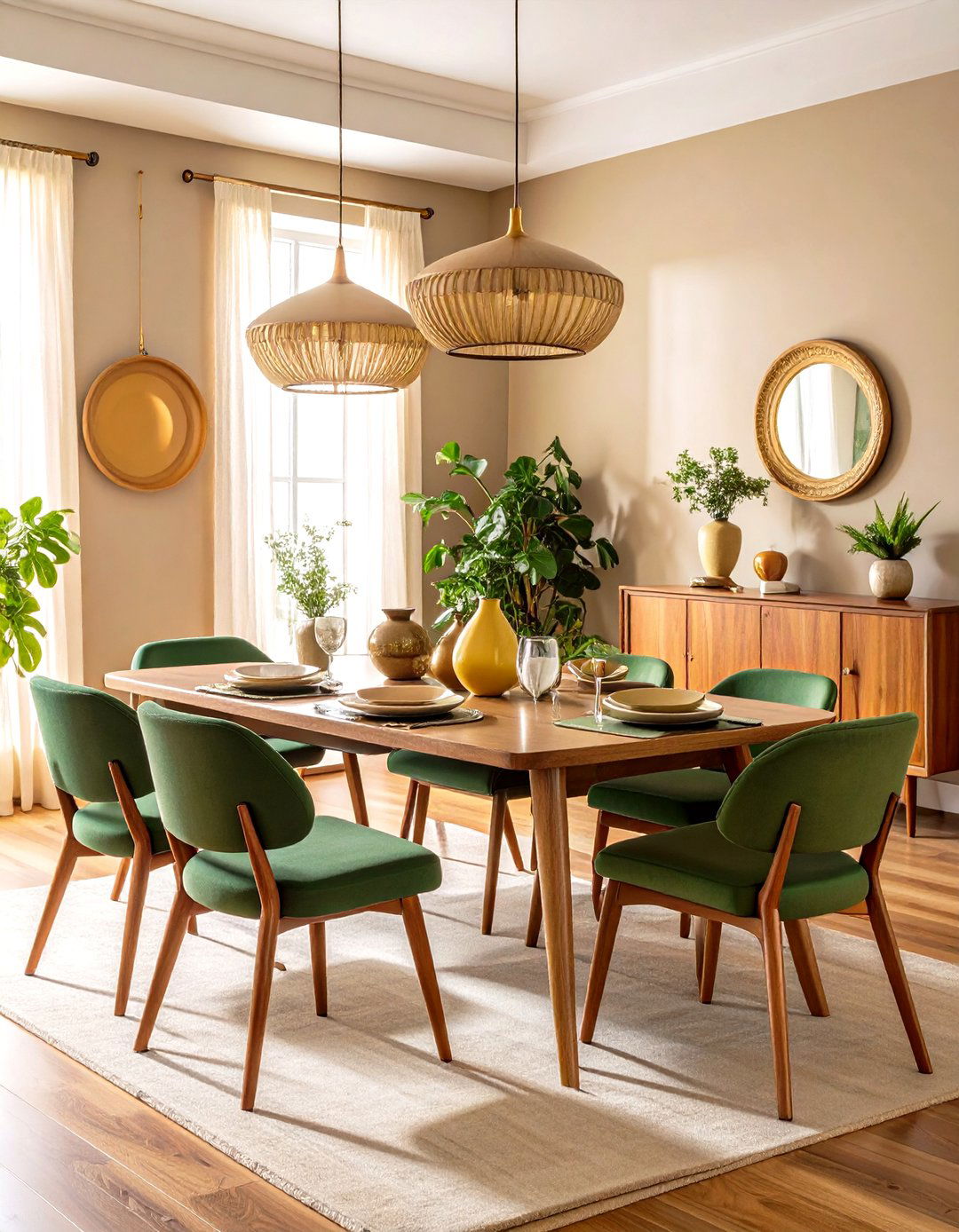
Avocado green cabinetry, burnt-orange linens, and mustard-yellow ceramics cloak a 70s dining room in cozy warmth. These hues pair beautifully with walnut veneers and brass fixtures, creating a palette that feels grounded rather than garish. To avoid a time-warp effect, distribute color deliberately: maybe an ochre rug underfoot, olive seat cushions, and amber glassware on open shelves. Keep walls neutral — think creamy beige — so the saturated accents feel intentional, not overwhelming. LED bulbs labeled “warm white 2700K” enhance the earthy scheme, delivering a gentle glow reminiscent of incandescent lighting without the energy drain.
7. Lucite Tables and Chairs Showcase Invisible Cool
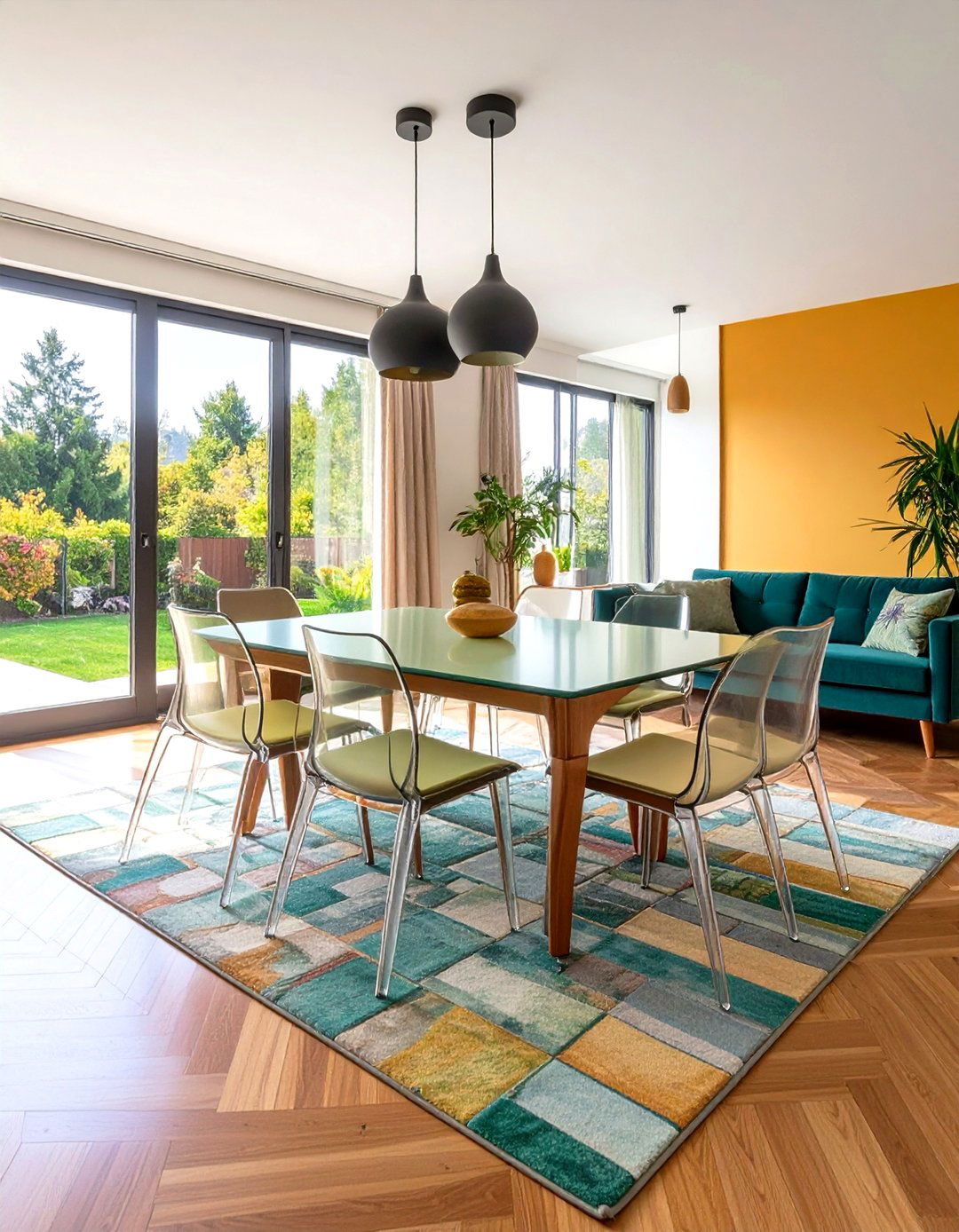
Transparent Lucite furniture epitomized futuristic chic in the late ’70s, and its crystal-clear surfaces still freshen a 70s dining room by creating the illusion of extra square footage. A rectangular Lucite table lets patterned rugs or parquet floors shine through, while see-through chairs tone down vibrant wallpapers because they visually disappear when not in use. Ensure materials are genuine acrylic — cheap polycarbonate may yellow over time. Clean with a microfiber cloth and mild soap to avoid scratches, and consider a tempered-glass top if you crave added protection from hot dishes. The result? A retro statement that feels weightless.
8. Shag Rugs Deliver Under-Table Comfort
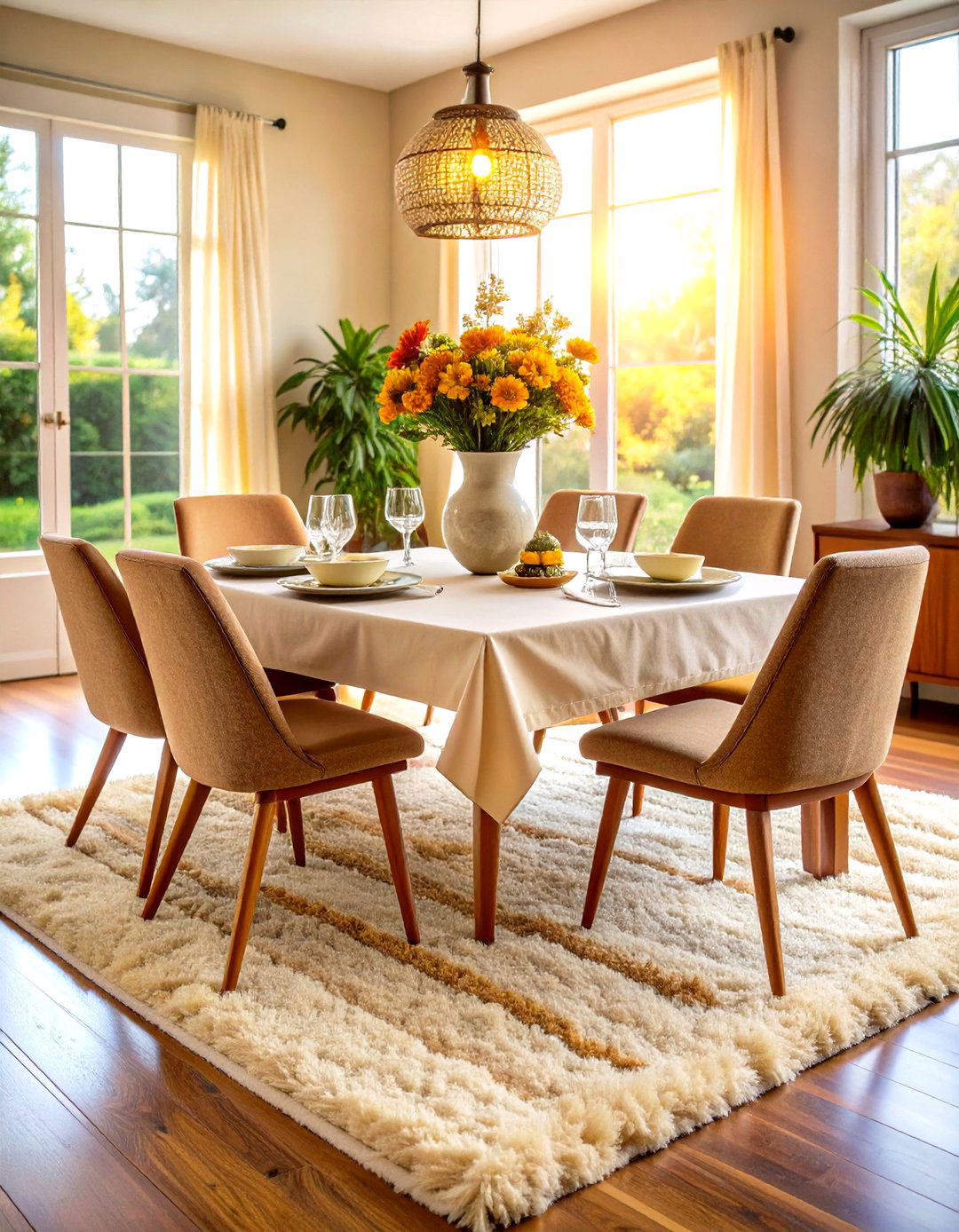
Slide bare feet into a plush shag rug, and suddenly your 70s dining room feels like a lounge. Opt for a medium-pile height (about 1. 5 inches) so chairs still glide easily. A round rug echoes a tulip table, while a long-haired rectangular version pairs with Parsons tables. Choose updated polypropylene blends if you need stain resistance; vintage wool alternatives offer luxe depth but demand gentler care. Regularly rotate and vacuum without a beater bar to prolong the tufts. Whether in cream for subtle texture or sunset stripes for drama, shag textiles ground the dining zone with irresistible coziness.
9. Globe Pendant Lights Cast Soft, Even Glow

The spherical opal-glass pendant remains a 70s icon, floating like a tiny moon above your 70s dining room. Hang a single oversized globe 30 inches above the tabletop for intimate lighting, or cluster three smaller globes at staggered heights for sculptural impact. Dimmable LED bulbs mimic the warm tone of vintage incandescents while saving energy. Brass or matte-black hardware interplays nicely with wood paneling and chrome chairs alike. Because globe shades diffuse light 360 degrees, they reduce harsh shadows, ensuring every diner — and every dish — looks flattering, even during late-night fondue sessions.
10. Terrazzo Surfaces Sprinkle Subtle Playfulness
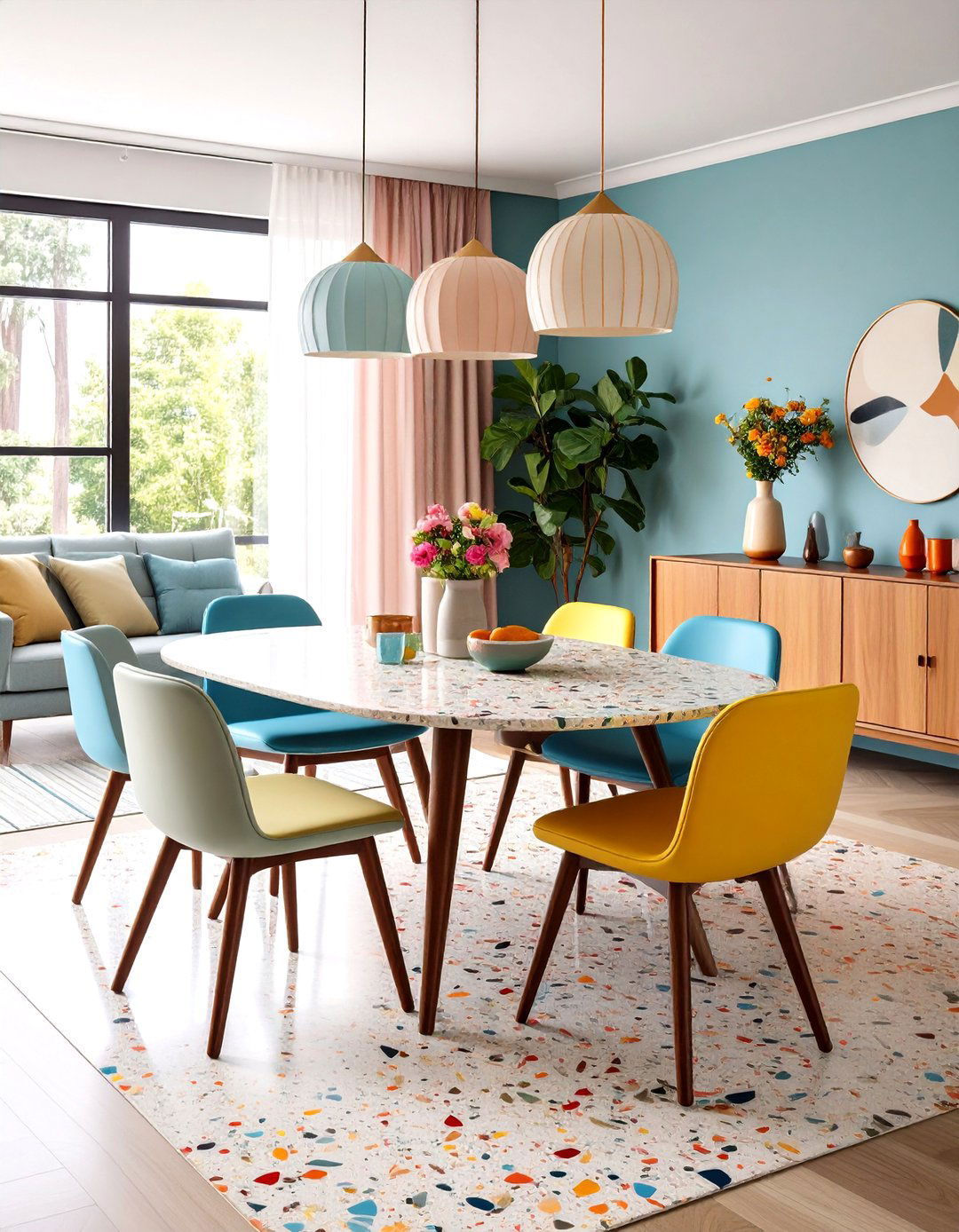
Peppered with colorful chips, terrazzo breathes playful sophistication into a 70s dining room. Install terrazzo tiles as a buffet backsplash or choose a terrazzo-look laminate tabletop to capture the speckled effect without hefty stone costs. The composite material’s random flecks cleverly tie together varied accent colors — harvest gold napkins, spruce green pottery, and rust upholstery — creating cohesive harmony. Matte sealers curb glare and protect against wine spills, while rounded edges echo the decade’s soft curves. Bonus: terrazzo’s cool surface doubles as a pastry-rolling zone for impromptu baking nights.
11. Patterned Linoleum Invites Easy-Clean Character
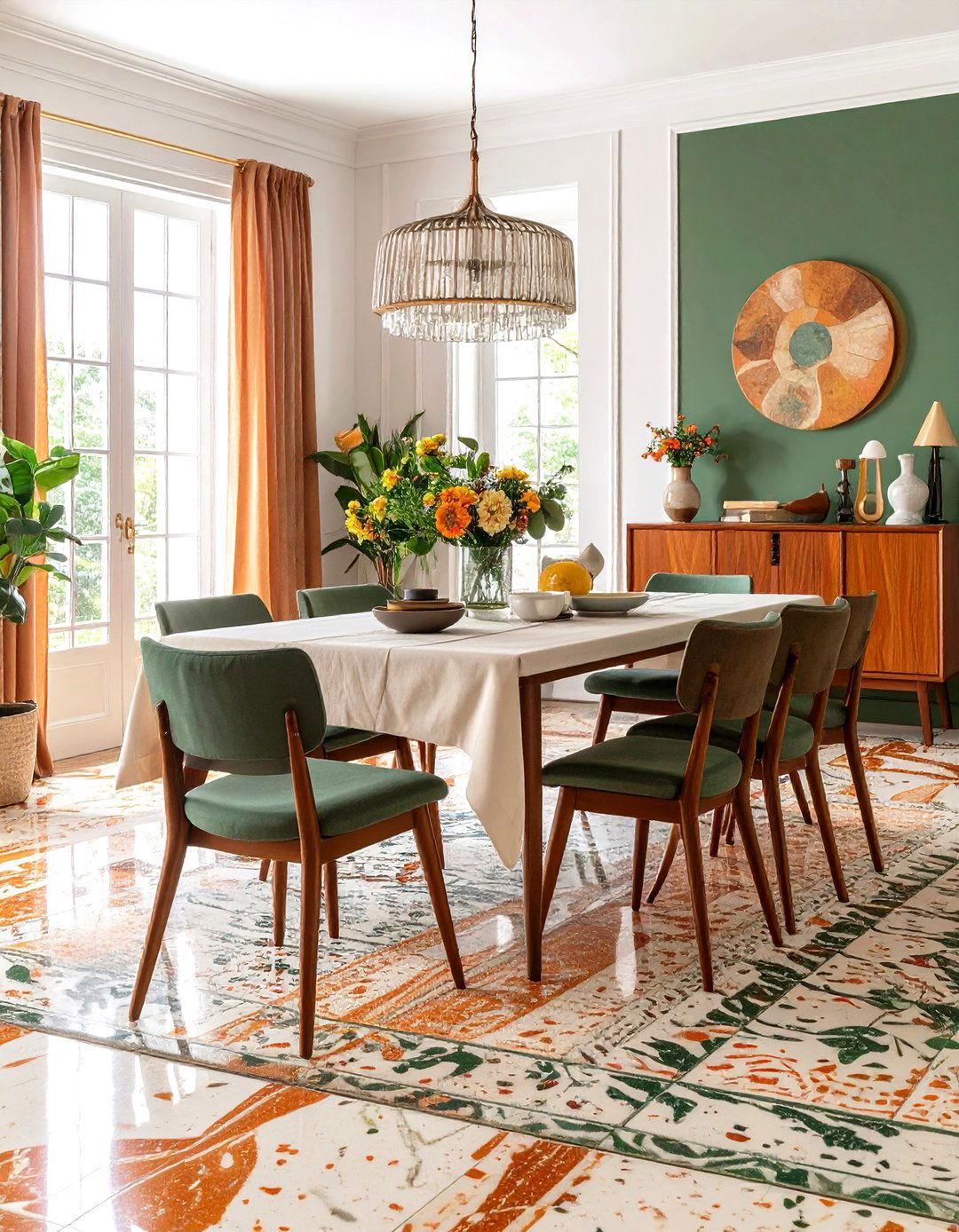
When vinyl flooring evolved into colorful linoleum prints in the 1970s, homeowners embraced checkerboards, faux cork, and floral swirls. Today’s updated linoleum retains that graphic punch while offering eco-friendly, low-VOC compositions. In a busy 70s dining room, its resilient surface shrugs off chair scoots and snack mishaps; a quick damp mop restores shine. Select marbled burnt-sienna stripes or ivy-green geometric repeats to anchor retro furnishings. Install as click-lock planks if you’re a renter wanting reversible flair. Tie in wall art with one accent color from the flooring for deliberate cohesion.
12. Jungle Greens Turn the Room into an Oasis
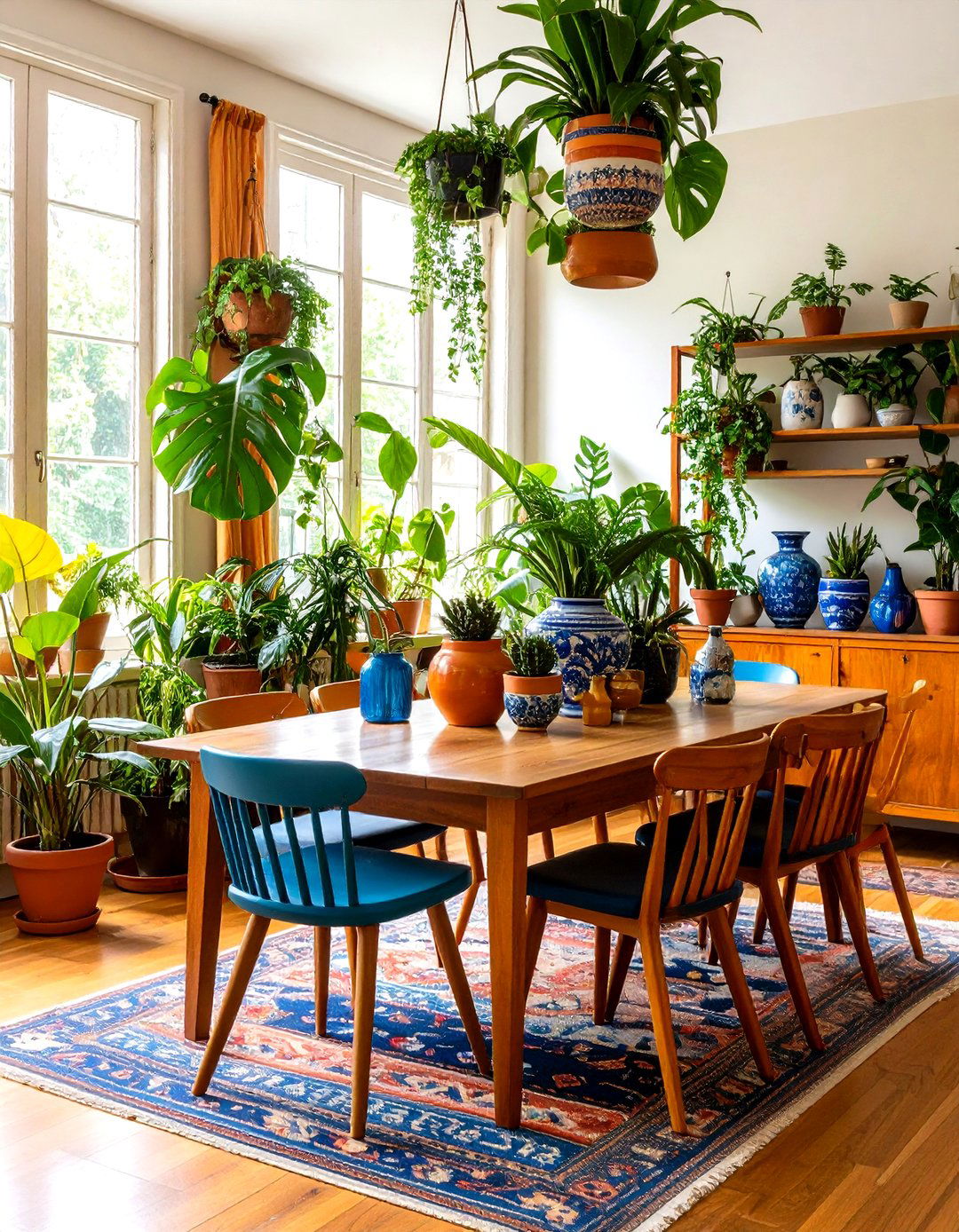
Few trends from the ’70s resonate today like the passion for houseplants. Cluster monsteras, spider plants, and trailing philodendrons on plant stands to give your 70s dining room a lush, oxygen-rich ambiance. Layer heights: low floor baskets, mid-level stands, and high macramé slings offer visual depth. Woven planters reinforce rattan furniture, while glazed ceramic pots echo retro dinnerware. Rotate plants each watering cycle to keep growth even, and use moisture meters to prevent overwatering. The leafy canopy moisturizes air, softens acoustics, and makes every meal feel like a picnic in a tropical conservatory.
13. Modular Sideboards Offer Flexible Storage
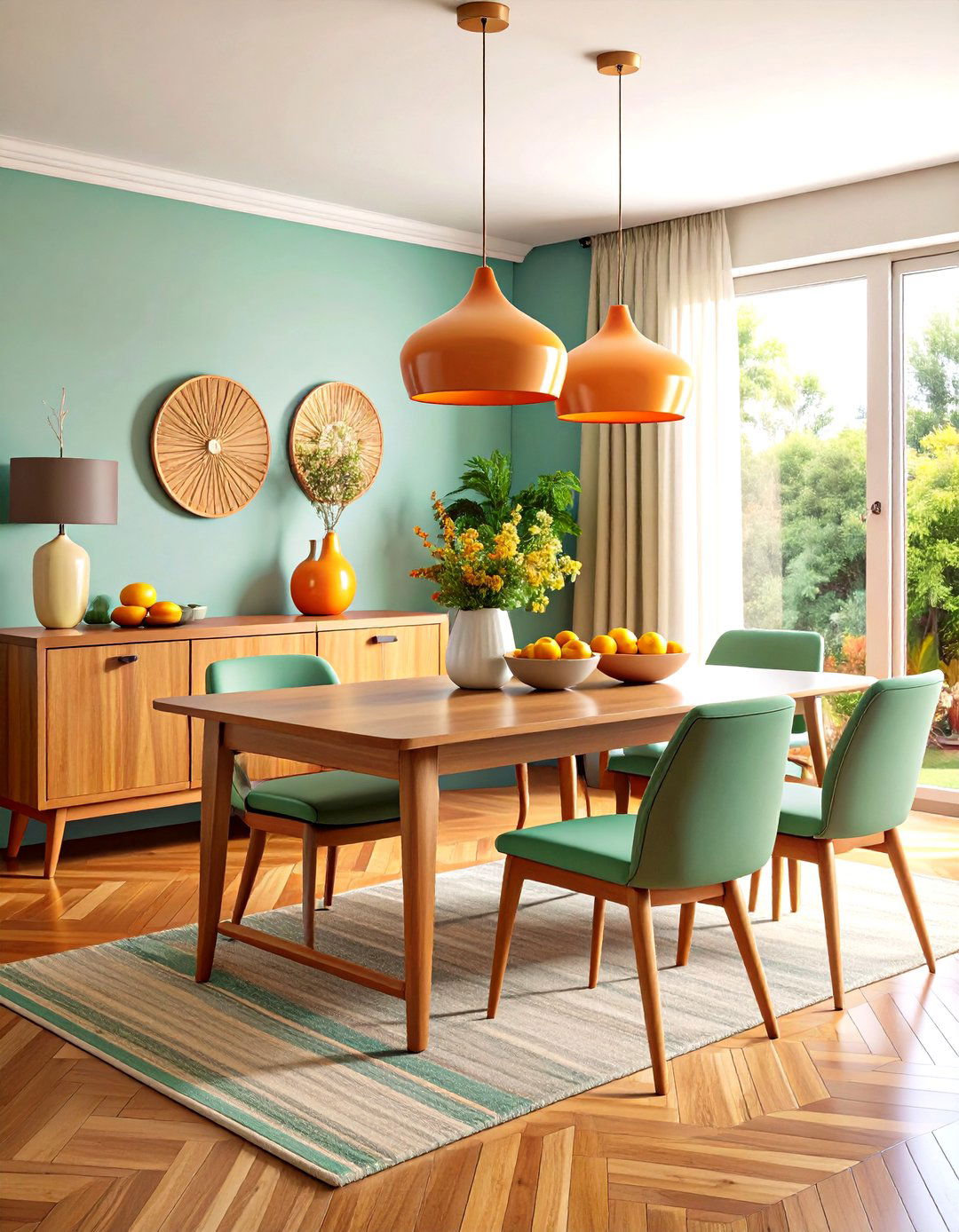
Modular storage rose to fame during the ’70s, matching the decade’s fluid lifestyles. A low, expandable teak or rosewood sideboard tucks extra dinnerware away while allowing you to rearrange sections for changing needs. In a modern 70s dining room, choose units with sliding tambour doors — signature grooved panels that glide rather than swing, conserving floor space. Add panel inserts in avocado or rust for era authenticity. Cable-management grommets let one segment double as a vinyl record station, amplifying functionality. Top the sideboard with chunky ceramic lamps and citrus fruit bowls for easy, everyday styling.
14. Harvest Gold Dinnerware Displays Celebrate Color
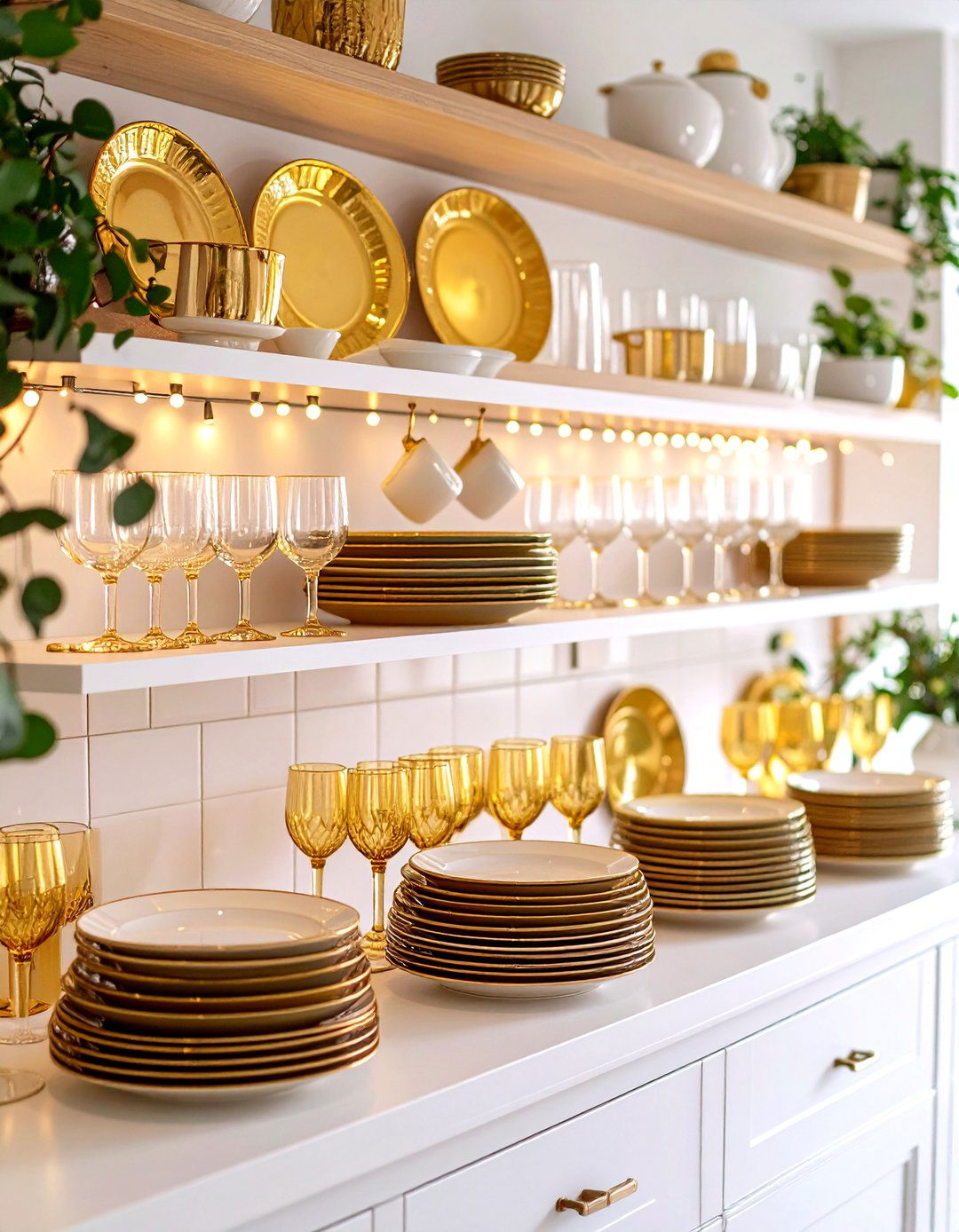
Open shelving spotlighting harvest-gold dinnerware injects sunny personality into a 70s dining room. Stack ceramic plates, place matching mugs on hooks beneath, and weave in brown-rimmed glasses for tonal depth. Vintage pieces abound at flea markets; pair them with modern matte-black flatware to dodge a theme-party vibe. Keep shelves a simple white or pale maple so the ochre pops, and install under-shelf puck lights to illuminate the collection during evening gatherings. Displaying plates also frees cabinet space, making this vibrant approach both practical and uplifting.
15. Vinyl-Upholstered Chairs Add Practical Pop
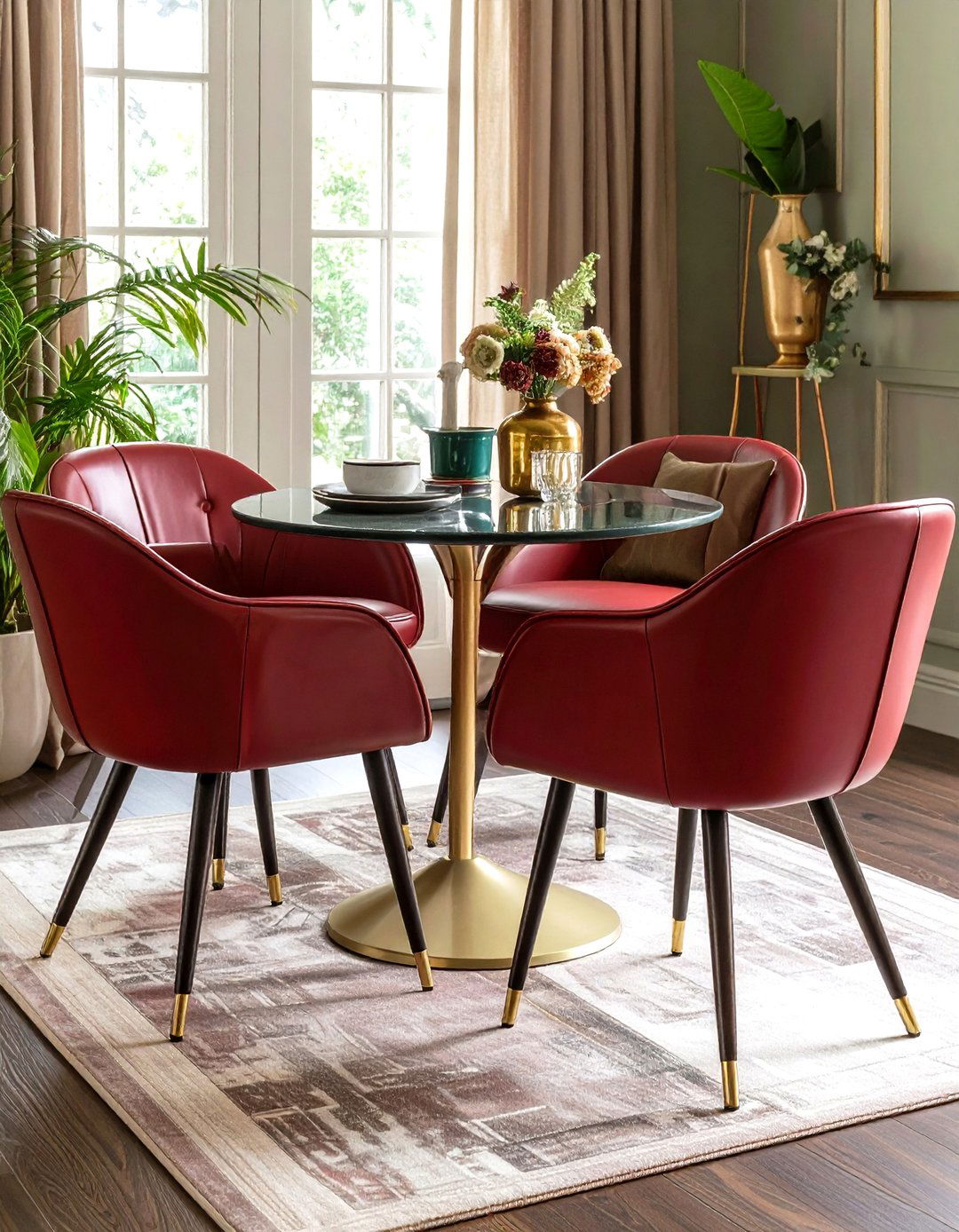
Durable, wipe-clean vinyl made 1970s dining furniture ideal for young families — and it’s just as sensible now. Choose scoop-back chairs wrapped in cherry red or deep teal vinyl for instant retro cheer. High-density foam cushions increase comfort, while powder-coated steel legs resist scuffs. In small 70s dining rooms, glossy vinyl reflects light, subtly enlarging the space. Keep a leather conditioner on hand to maintain suppleness, and patch tiny tears with color-matched repair kits to extend life. Pair the chairs with muted table linens to avoid color overload and let the seats shine.
16. Wood-Panel Accent Walls Warm Up Minimalist Layouts
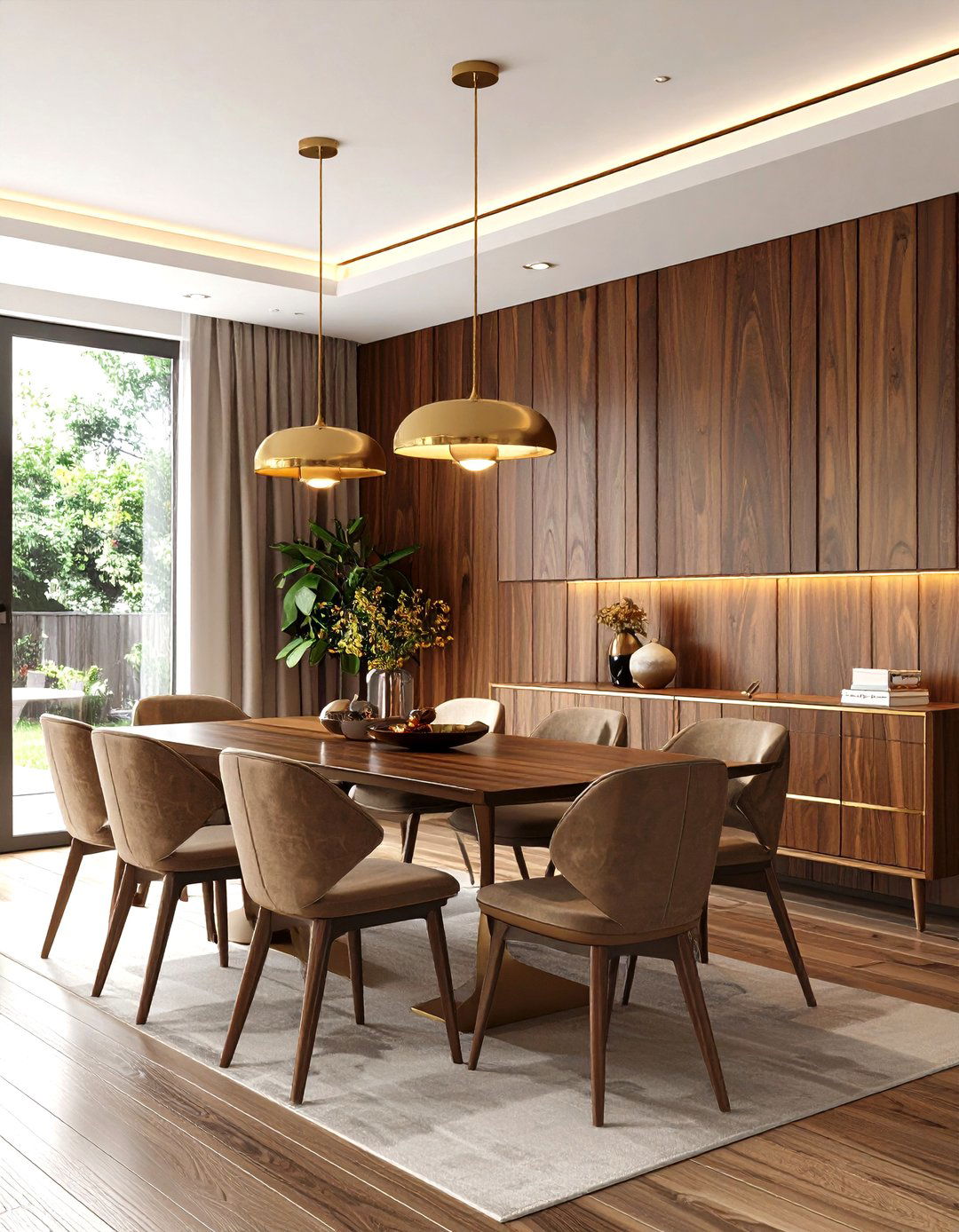
A single wall clad in vertical walnut veneer panels nods to mid-century dens yet feels surprisingly current. In a white-walled 70s dining room, the wood’s rich grain supplies cozy contrast while muffling sound. Opt for peel-and-stick planks for an afternoon DIY, and run LED strip lighting along the ceiling edge to highlight texture at night. Break up long expanses with narrow brass picture rails showcasing vintage album art. Because the rest of the room remains light, the paneling reads deliberate and upscale, not dated basement, striking a refined retro balance.
17. Chrome Cantilever Chairs Inject Sleek Shine
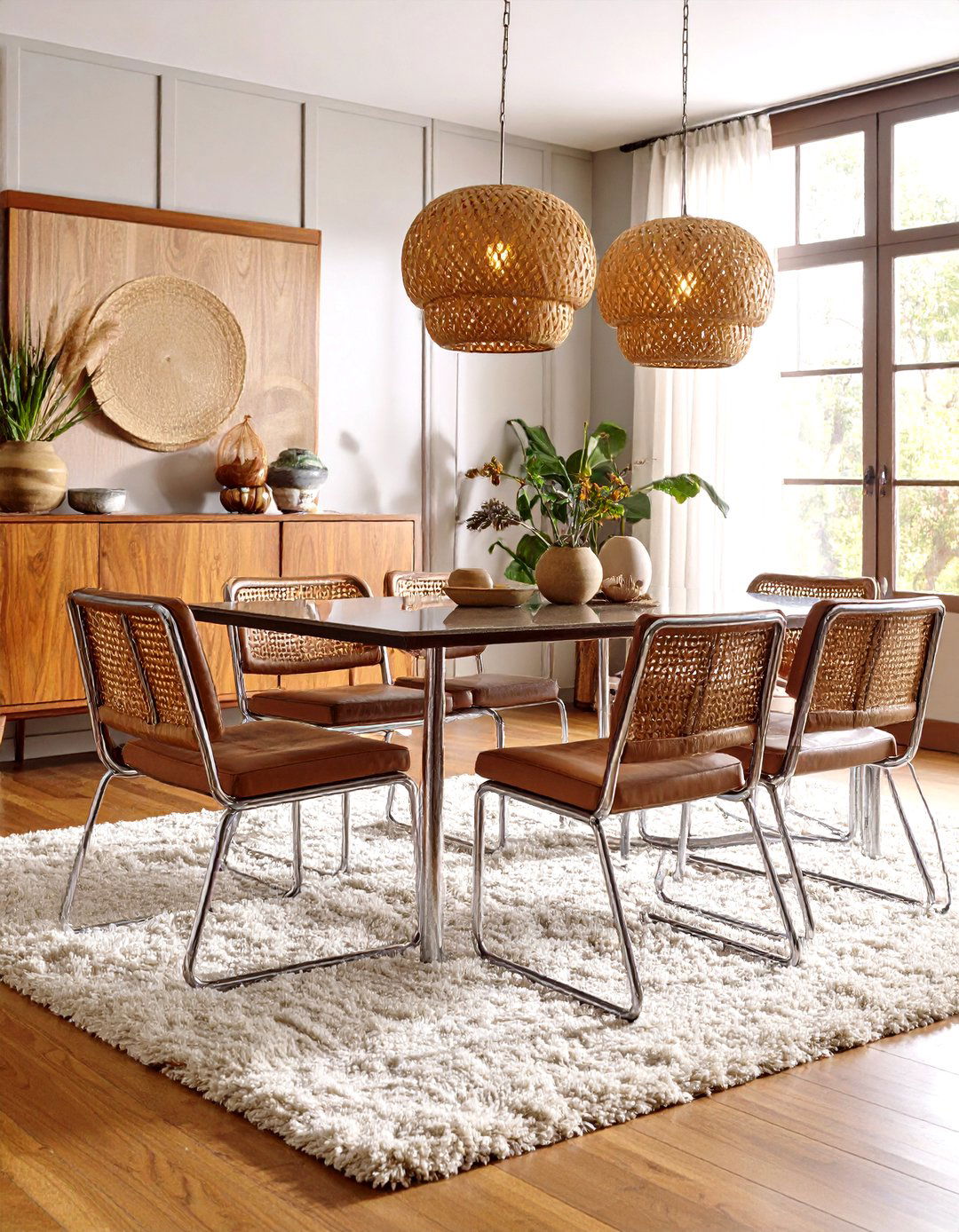
Marcel Breuer-inspired chrome cantilever chairs bring Bauhaus lineage into a 70s dining room, their airy frames creating bounce and visual lift. Pair them with a glossy laminate table for an almost weightless ensemble that counterbalances heavy shag rugs or paneled walls. Woven cane or padded leather seats add warmth against the cool metal; ensure glides are intact to protect flooring. Chrome’s reflective quality amplifies pendant lighting, expanding brightness in compact rooms. Occasional polishing removes fingerprints, keeping the steel sharp and futuristic — just as the decade imagined home seating would evolve.
18. Crochet Runners Layer Handmade Softness
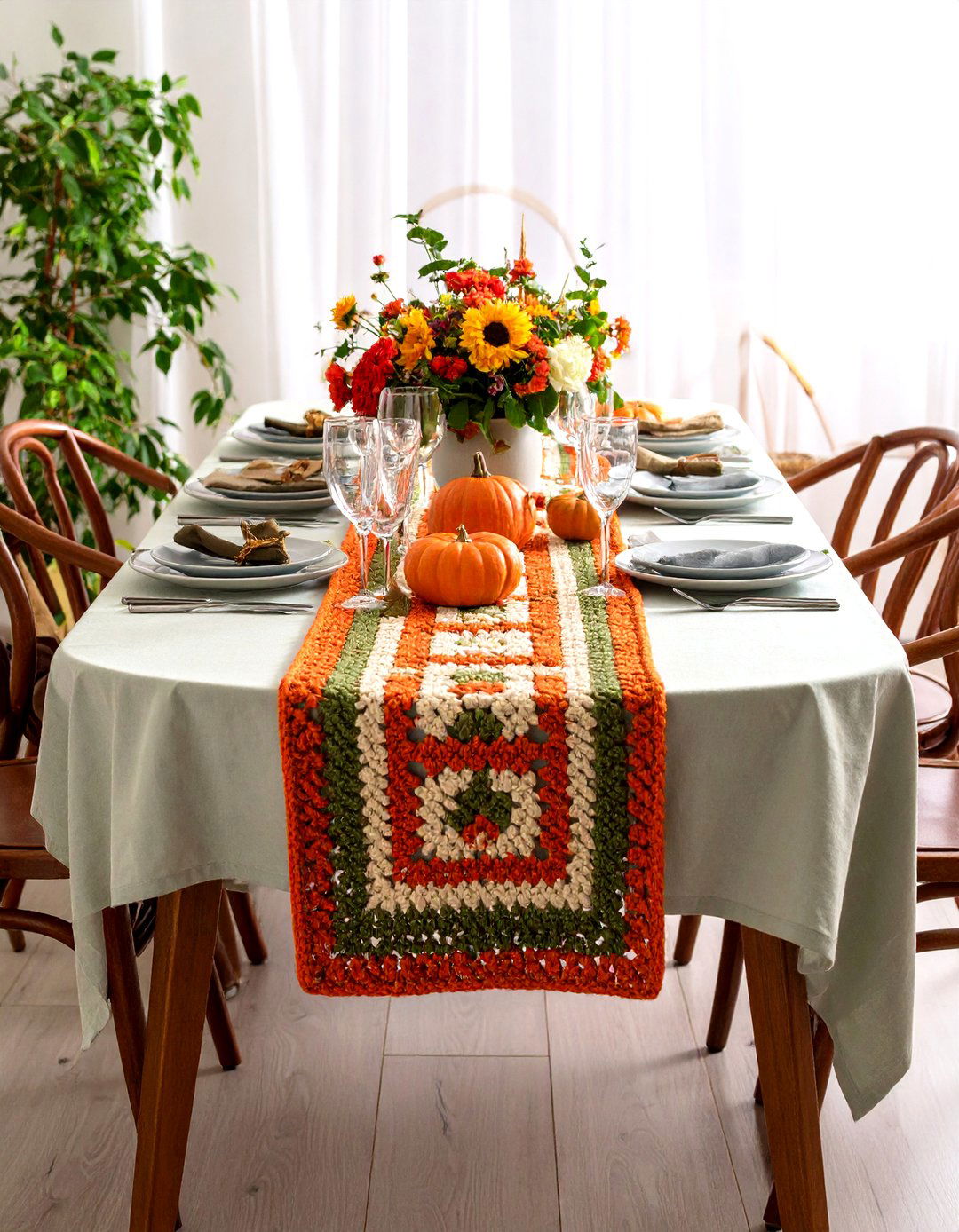
Soft, handmade crochet runners break the sleekness of tulip tables, infusing your 70s dining room with artisan charm. Choose open-weave granny-square motifs in pumpkin and cream or solid-stitch stripes in moss green. Because the yarn hugs tabletops, dishes stay steady during lively dinners. Machine-washable cotton blends simplify upkeep, while wool versions add insulating heft for colder climates. Contrast the runner’s tactile personality with smooth glassware and polished flatware for sensory balance. Fold extra runners into a rattan basket beside the sideboard so you can swap colors with the seasons.
19. A Mini Conversation Pit Encourages Lounge-Style Dining
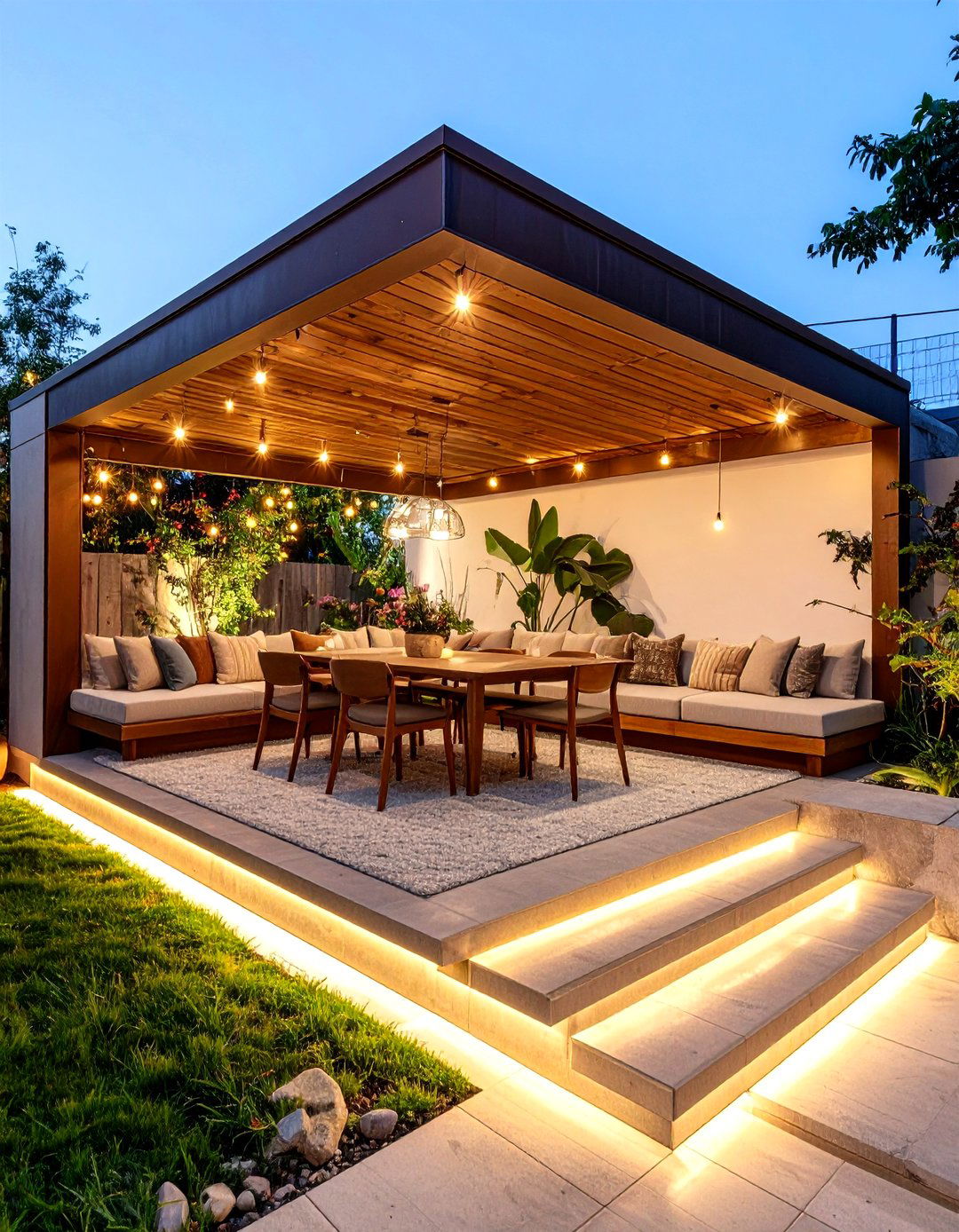
Borrow inspiration from iconic sunken living rooms by constructing a modest platform around the table. Two low steps down create an intimate 70s dining room nook where diners settle into built-in bench seating stuffed with corduroy cushions. The slight grade change delineates the eating zone in open-plan homes without erecting walls. Use durable carpet tiles for easy cleaning and consider recessed LED tread lights to prevent trips. This micro pit invites casual stretching and post-meal card games, blurring boundaries between dining and lounging just like original ’70s interiors intended.
20. Beaded Curtains Set a Playful Threshold
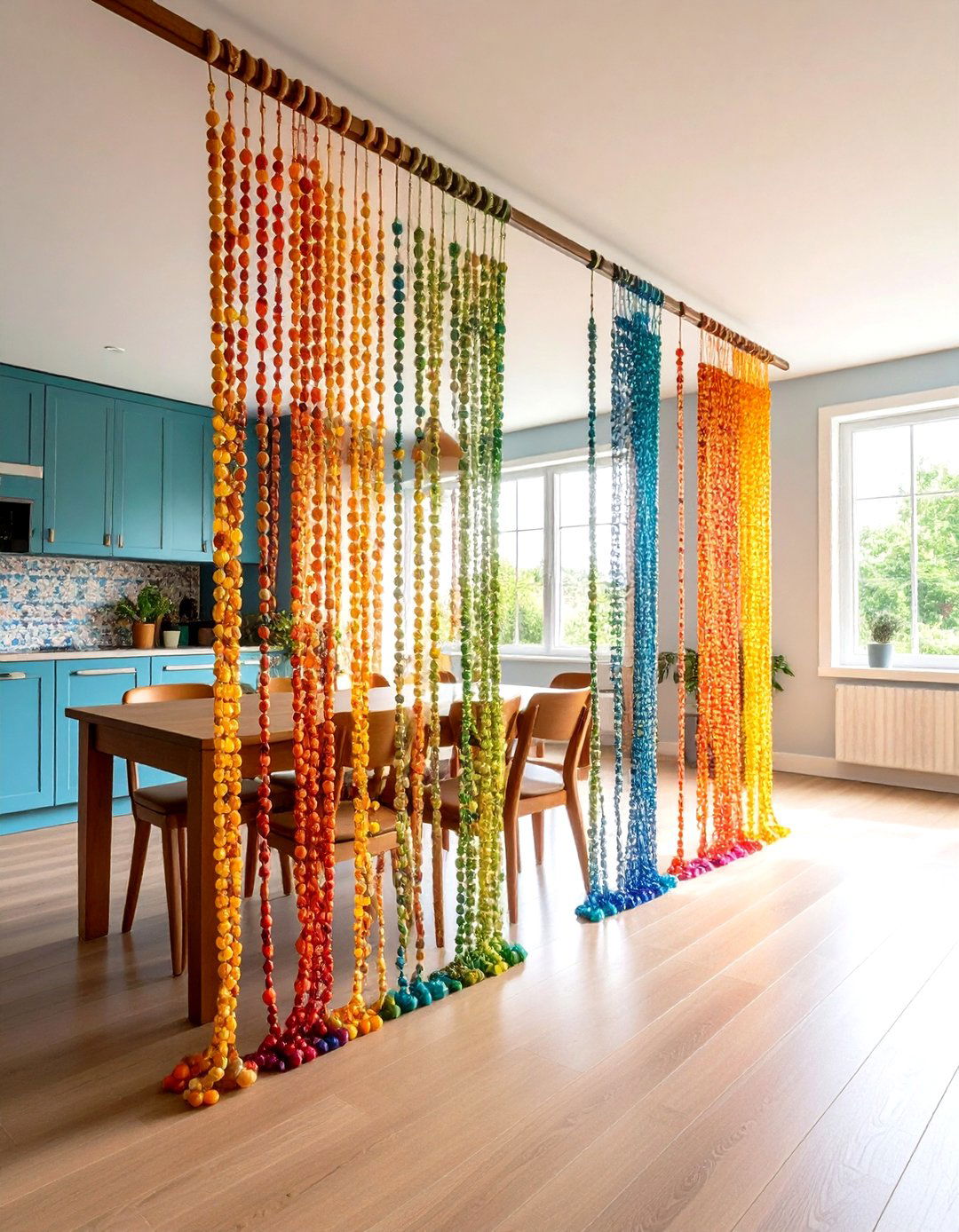
Swap a solid door for beaded curtains to transition between kitchen and 70s dining room areas with a whisper of nostalgia. Choose natural wooden beads for subtle rhythm or rainbow acrylic strands for a disco vibe. The gentle clatter alerts hosts to arriving guests, handy during buffet nights. Hang the curtain from tension rods inside the frame so landlords stay happy. Dust beads periodically with a paintbrush, and loop back the strands on heavy-traffic days. This lightweight divider lets aromas circulate while visually signaling that the dining zone is a special, laid-back enclave.
21. Geometric Art Prints Anchor the Walls

Oversized geometric serigraphs — think concentric squares or bold chevrons — capture the confident artistry of the ’70s and keep walls from feeling bare. In a 70s dining room, a single 36-by-36-inch print above the sideboard can echo rug or upholstery patterns, tying the scheme together. DIY your own using painter’s tape and two retro paint colors for budget-friendly flair. Use thin walnut frames so the art floats without overpowering the print. Glass with low-glare coating prevents harsh reflections from pendant lights, ensuring the dynamic shapes remain crisp from every angle.
22. Colored Glass Bar Carts Spark Entertaining Joy
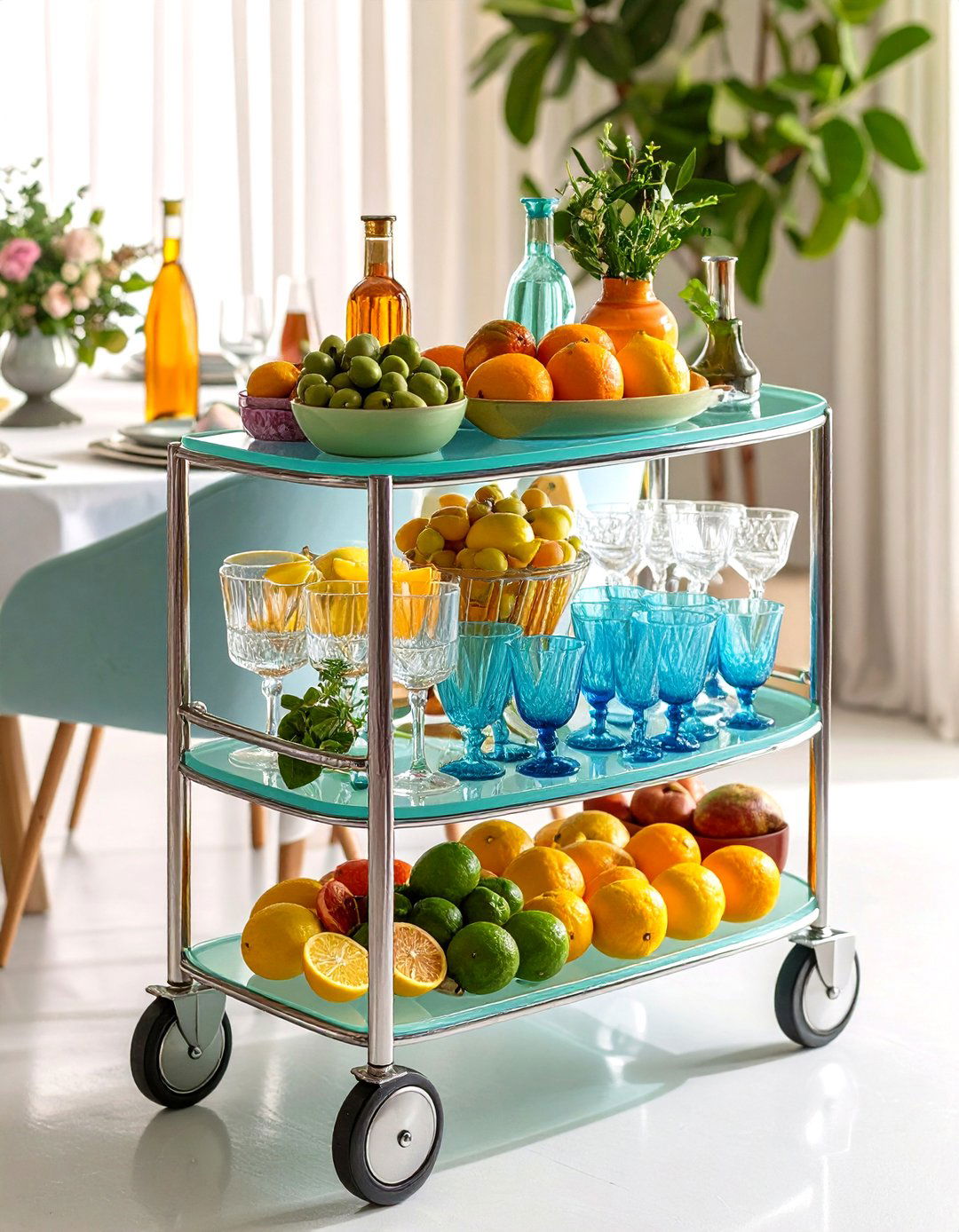
Rolling in on chrome wheels, a glass-shelved bar cart stacked with amber tumblers, olive decanters, and ruby cordial glasses sets a festive tone. Parking one beside a 70s dining room table frees surface space while inviting guests to mix drinks or sparkling water. Choose tempered colored glass shelves to spotlight vintage hues and easy-clean durability. Stock with a simple tray of citrus, a retro ice bucket, and patterned cocktail napkins. When dinner ends, relocate the cart to the living room, proving its versatility. Locking casters keep the collection secure on uneven floors.
23. Speckled Formica Surfaces Resist Daily Wear
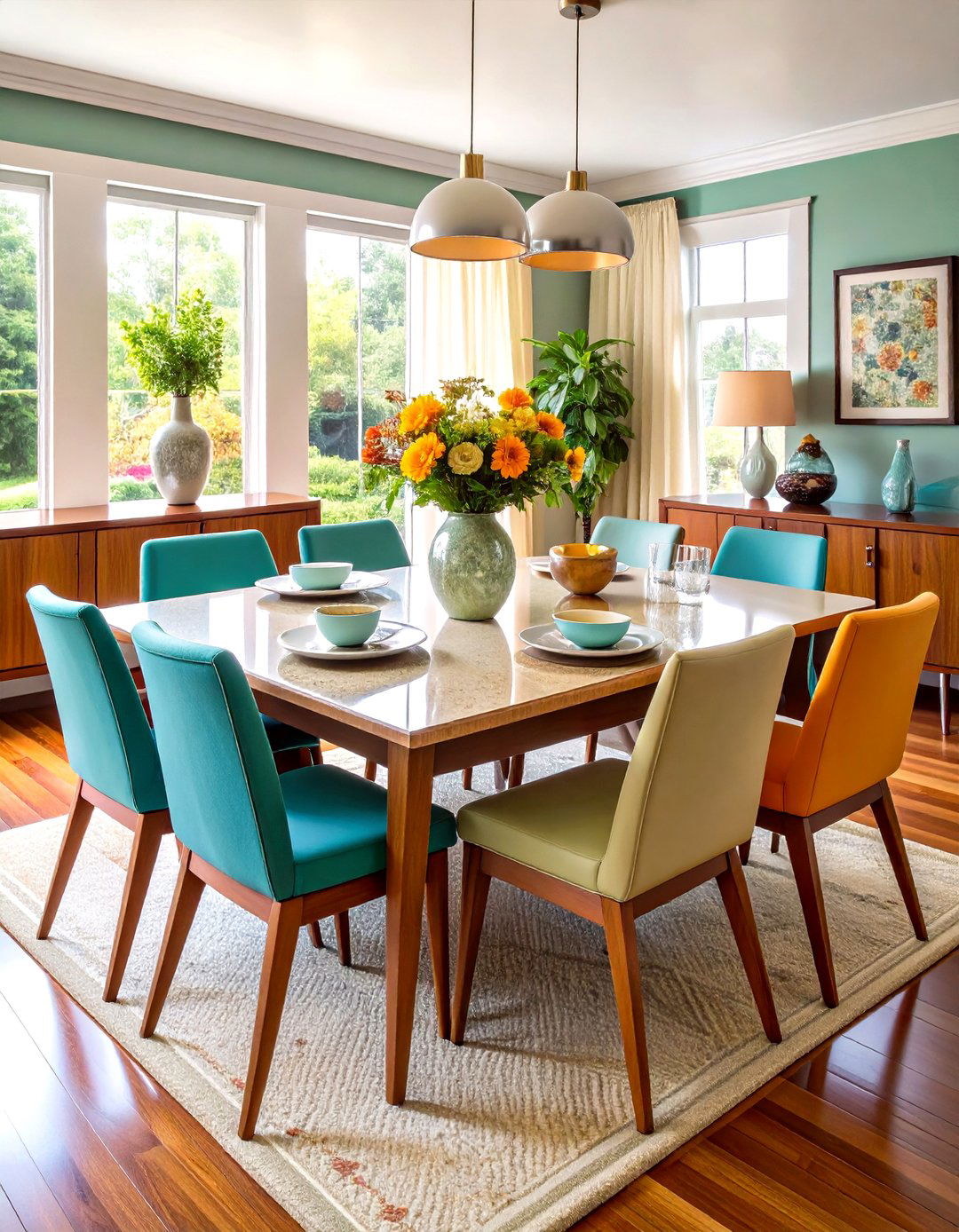
Formica’s speckled laminate countertops were kitchen staples in the ’70s, and the material’s durability translates perfectly to a hard-working 70s dining room tabletop. Modern high-pressure laminates replicate period patterns — think white flecked with charcoal or mustard dots — while boasting improved scratch resistance. Edge the slab with anodized aluminum trim for that classic dotted border. A damp microfiber cloth wipes away spills, making kid-friendly dinners stress-free. Because the surface reflects light subtly, it brightens rooms without the glare of polished stone, achieving functional retro cool on a reasonable budget.
24. Retro Record Corner Completes the Mood
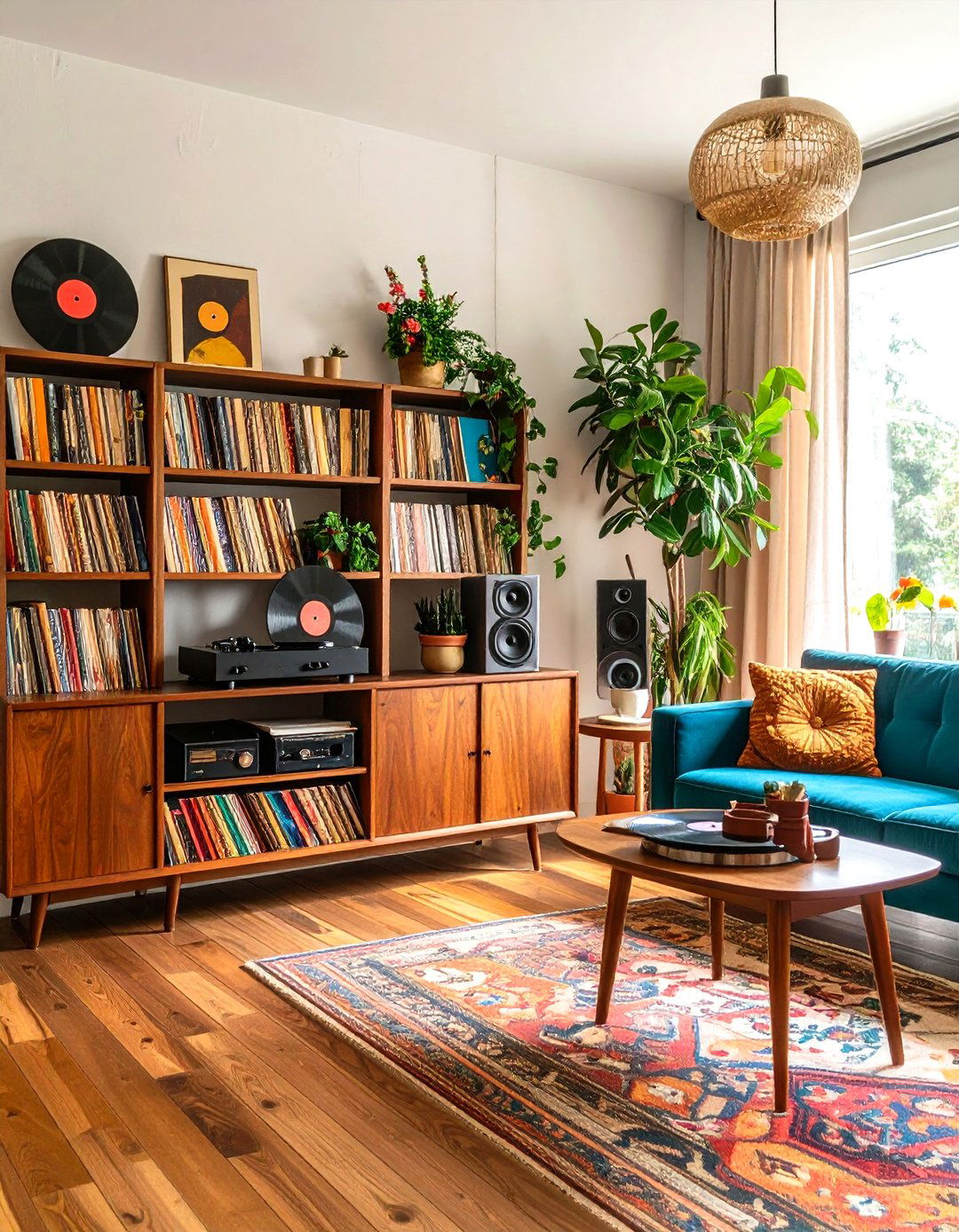
Set up a slim record cabinet and turntable in one corner to infuse your 70s dining room with the sound of crackling vinyl during meals. A stack of funk, soul, or classic rock LPs doubles as décor when their vibrant covers face outward. Plug modern Bluetooth speakers into the receiver so warm analog tones meet 2025 convenience. Ensure the unit sits level to avoid skips and keep a soft brush handy for routine dusting. The gentle background playlist fosters leisurely dining, sparking conversation as guests flip through titles between courses.
25. Painted Arches Frame Built-In Shelves
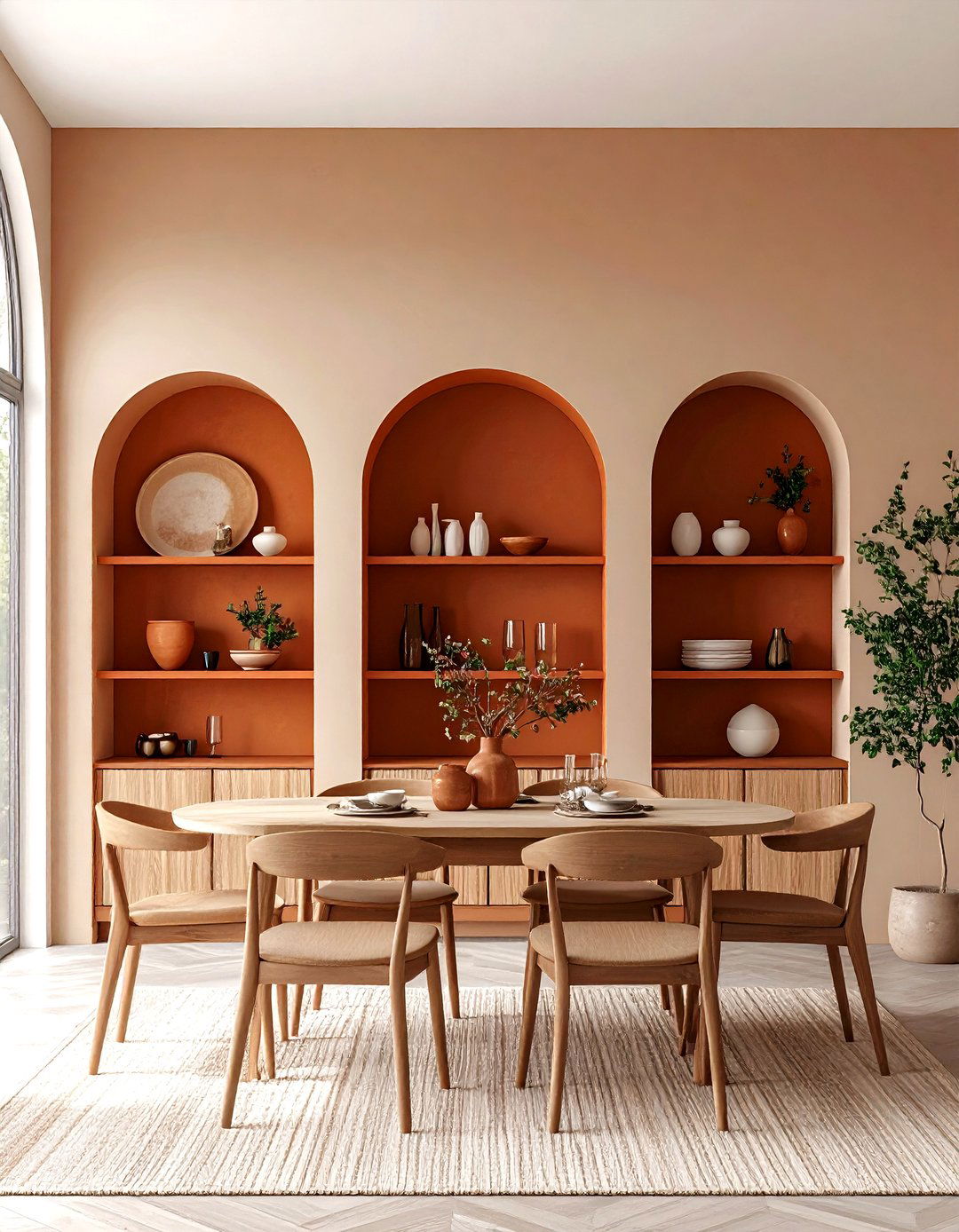
Finally, give your 70s dining room architectural charm by painting arch shapes around wall niches or shelving units. Trace half-circles with a string-and-pencil compass, then fill with spice-rack hues like burnt sienna or ochre using a semi-gloss finish for easy cleaning. The rounded silhouettes echo the era’s love of curves and instantly draw eyes to displayed ceramics or glassware. Pair arches in complementary pairs — one large, one small — for visual rhythm, and extend the color onto shelf edges for seamless integration. This low-cost weekend project delivers depth and a cheeky wink to retro interiors.
Conclusion:
Tapping into 1970s design means embracing warmth, personality, and fearless individuality — qualities that feel more relevant than ever in our digitally saturated world. From iconic tulip tables and tactile rattan chairs to bold wallpapers and cosmic globe lights, each idea above shows how a thoughtful 70s dining room perfectly balances nostalgia with everyday ease. Layering rich palettes, playful textures, and conversation-sparking accents transforms mealtime into a joyful ritual, inviting family and friends to gather, linger, and connect. Harness these retro elements selectively or all at once, and your dining space will radiate authenticity, comfort, and timeless groove.


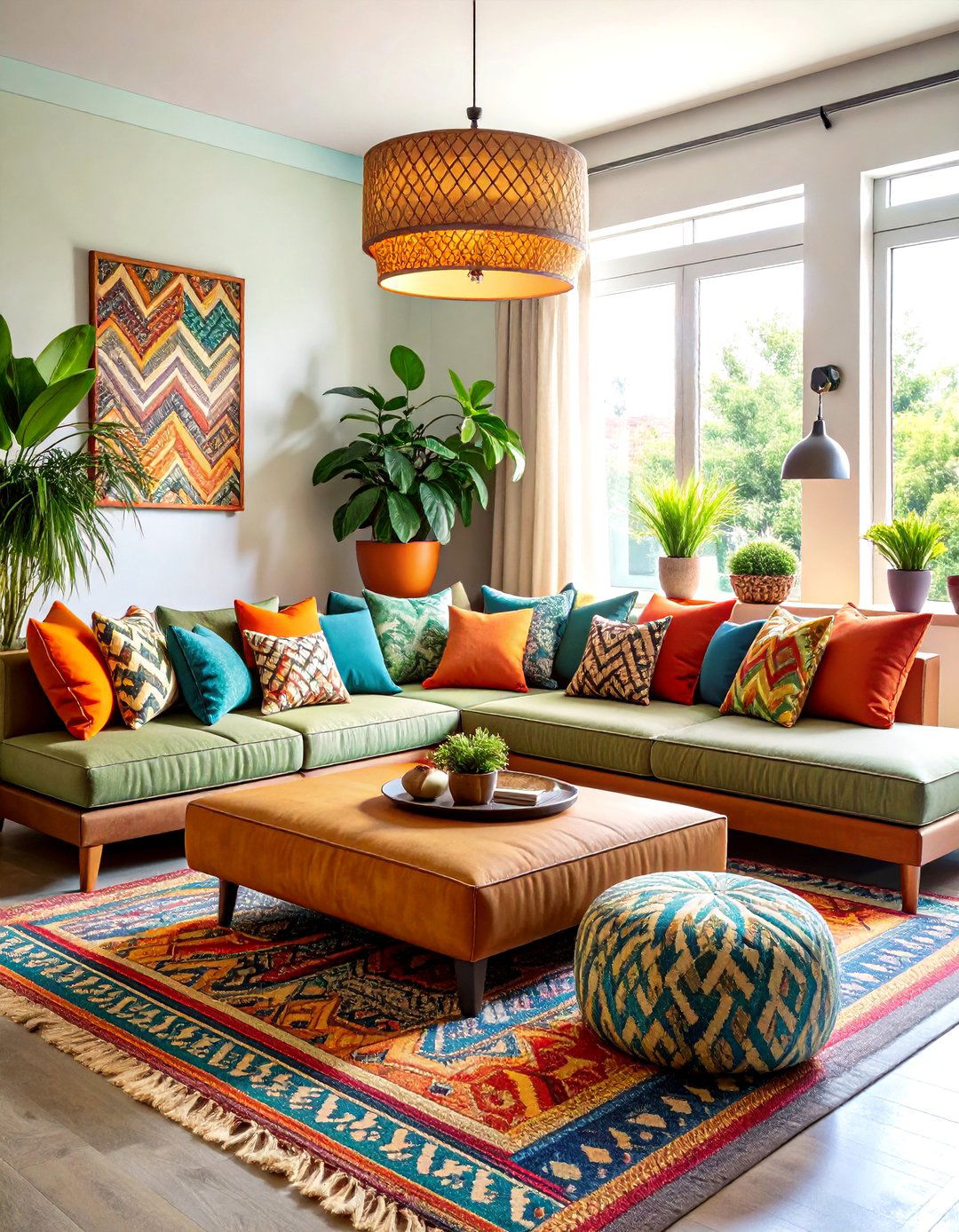
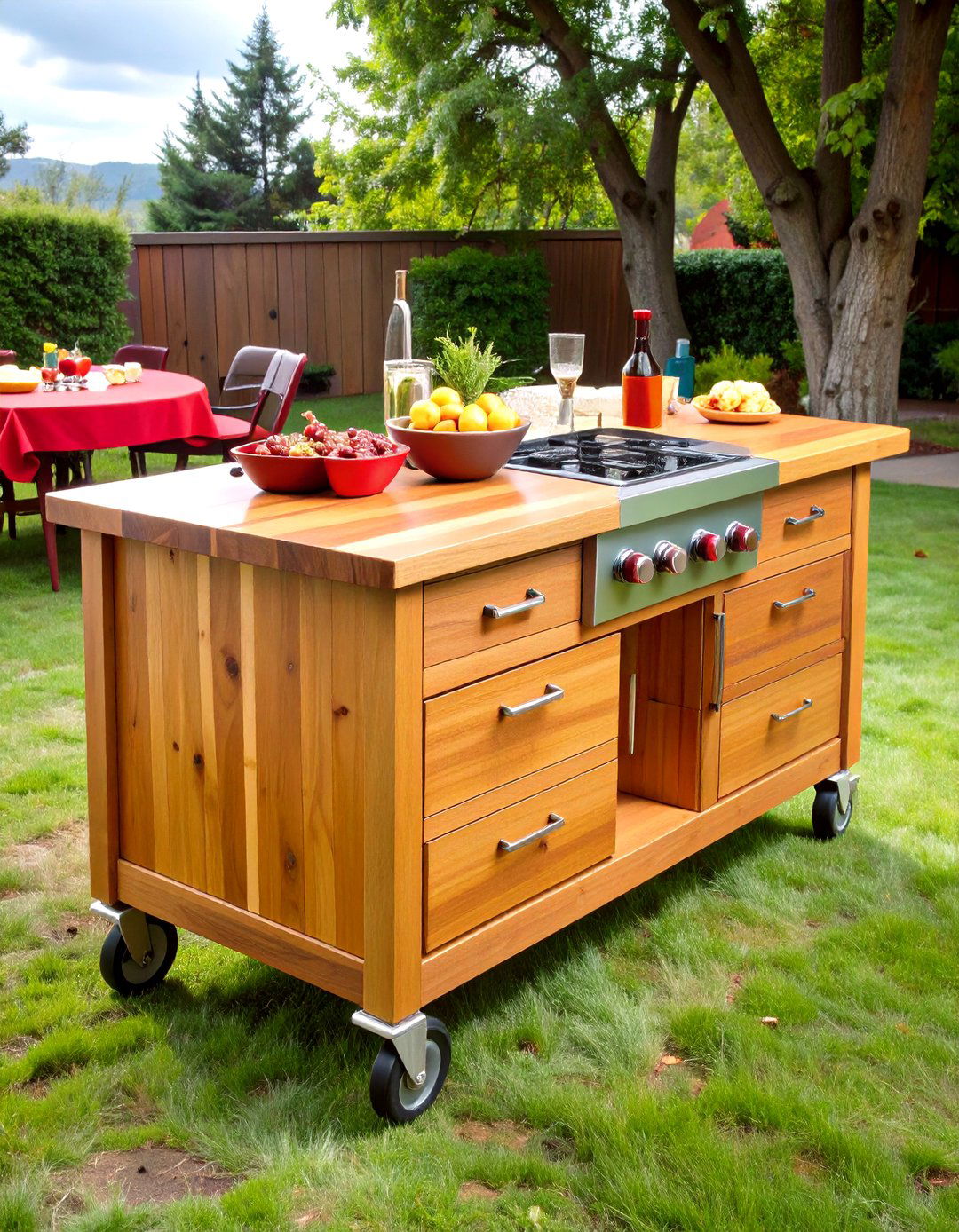
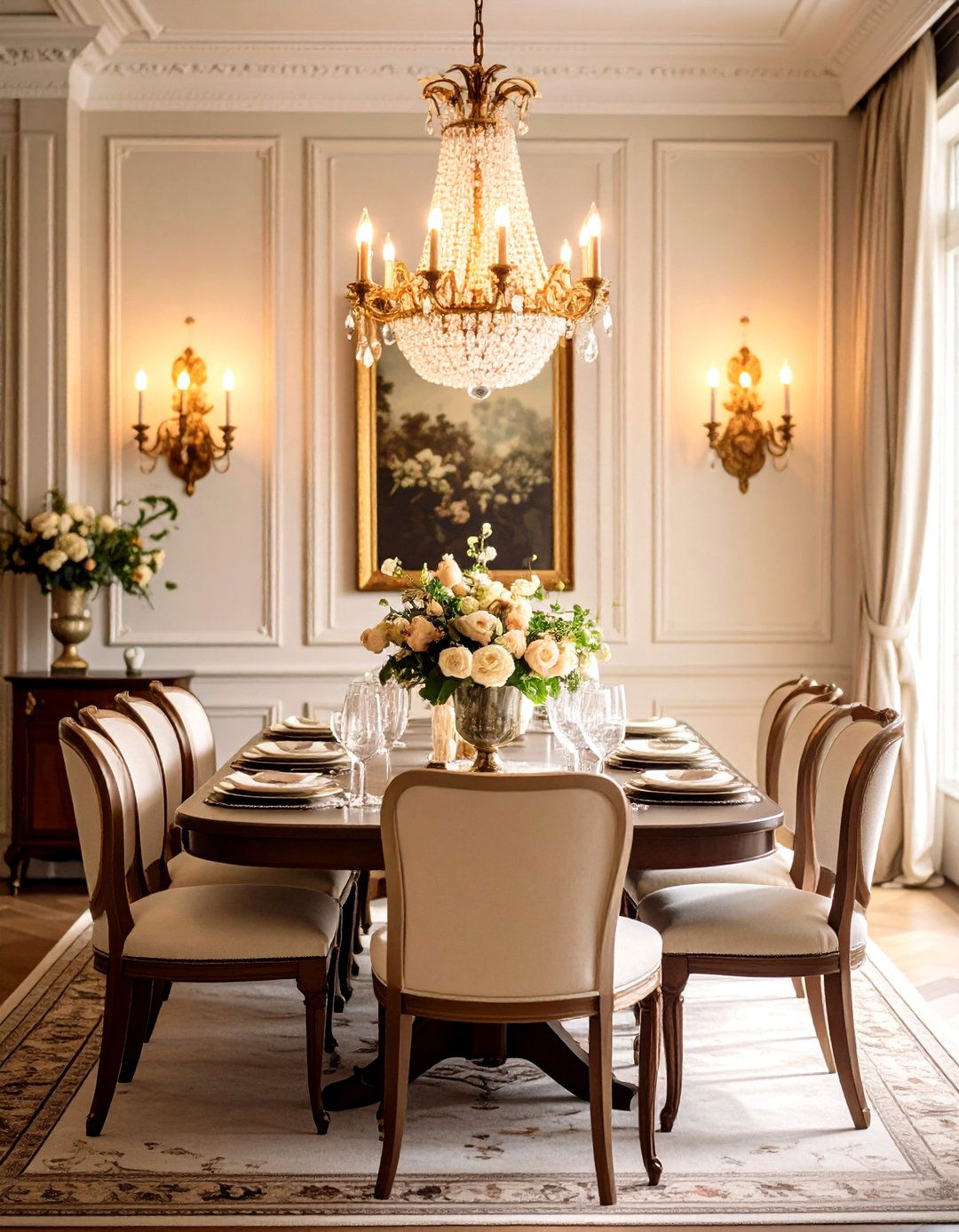
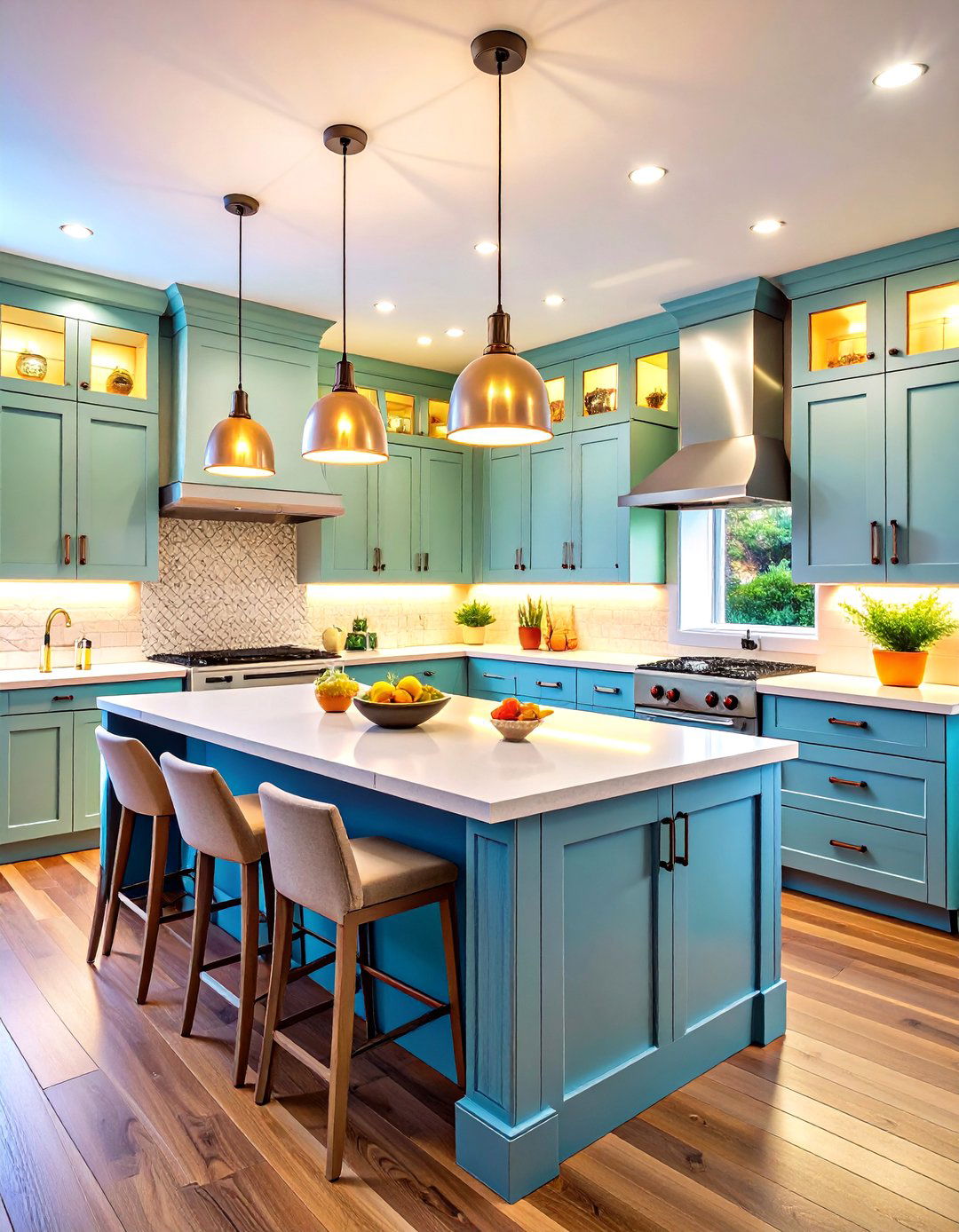
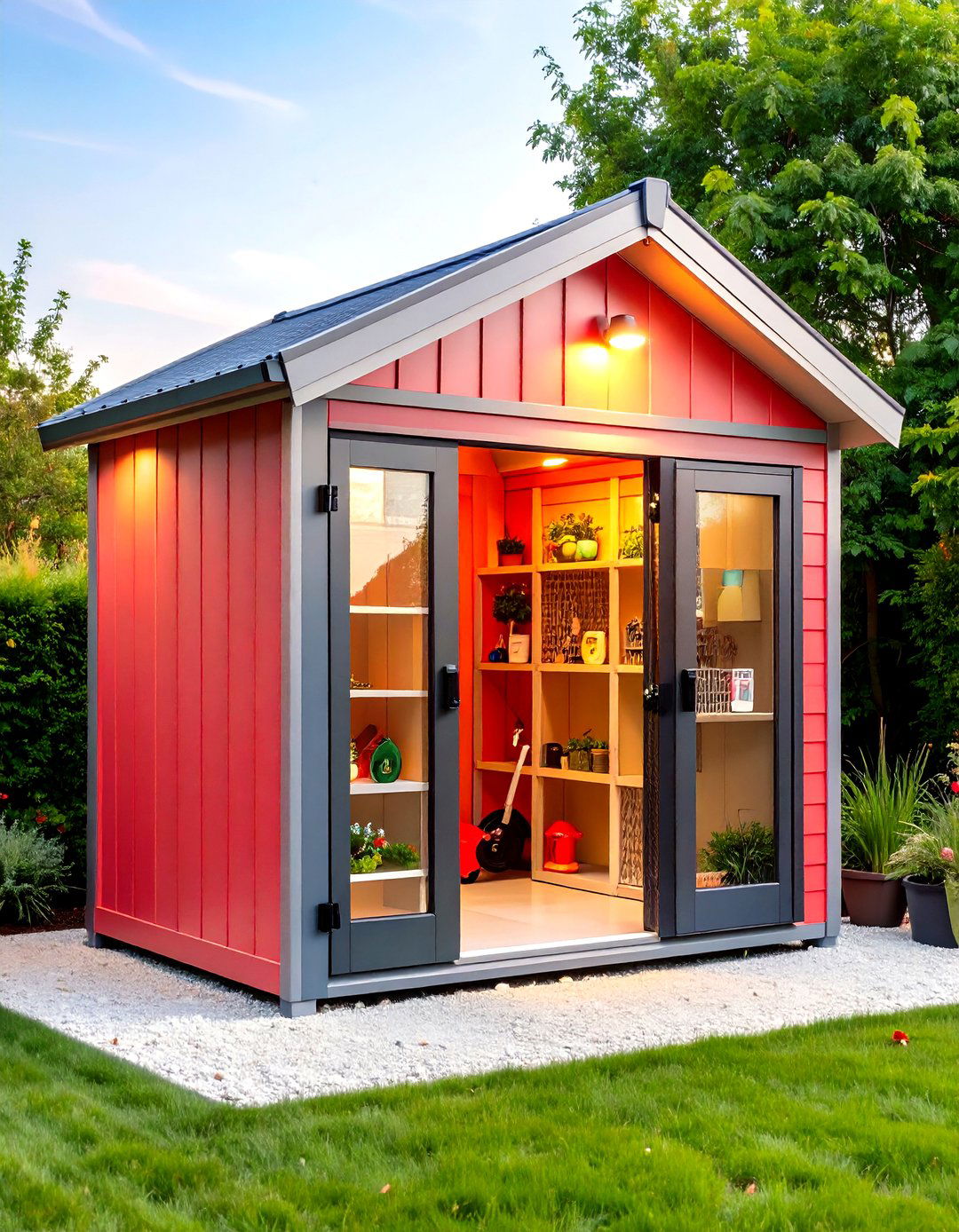
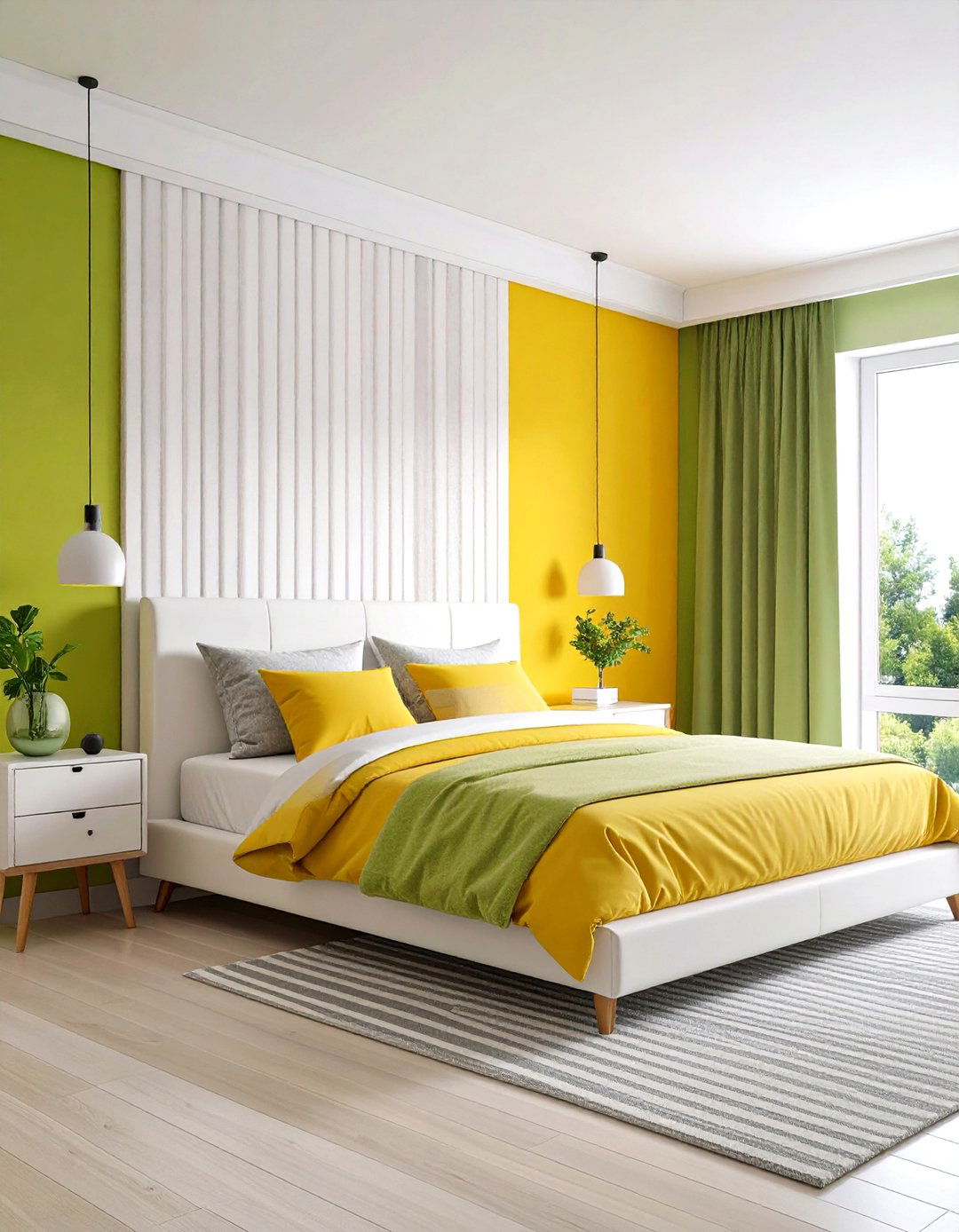
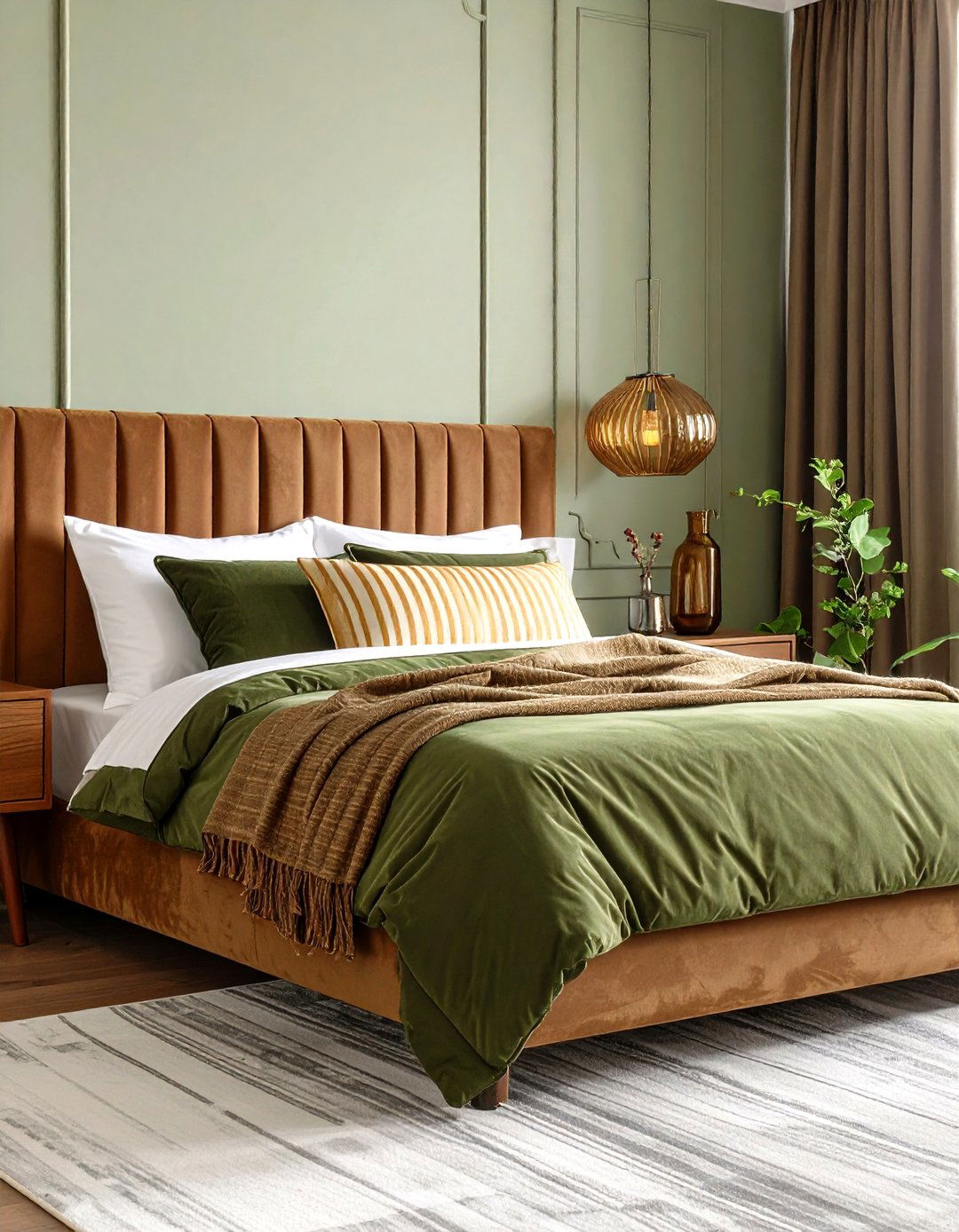
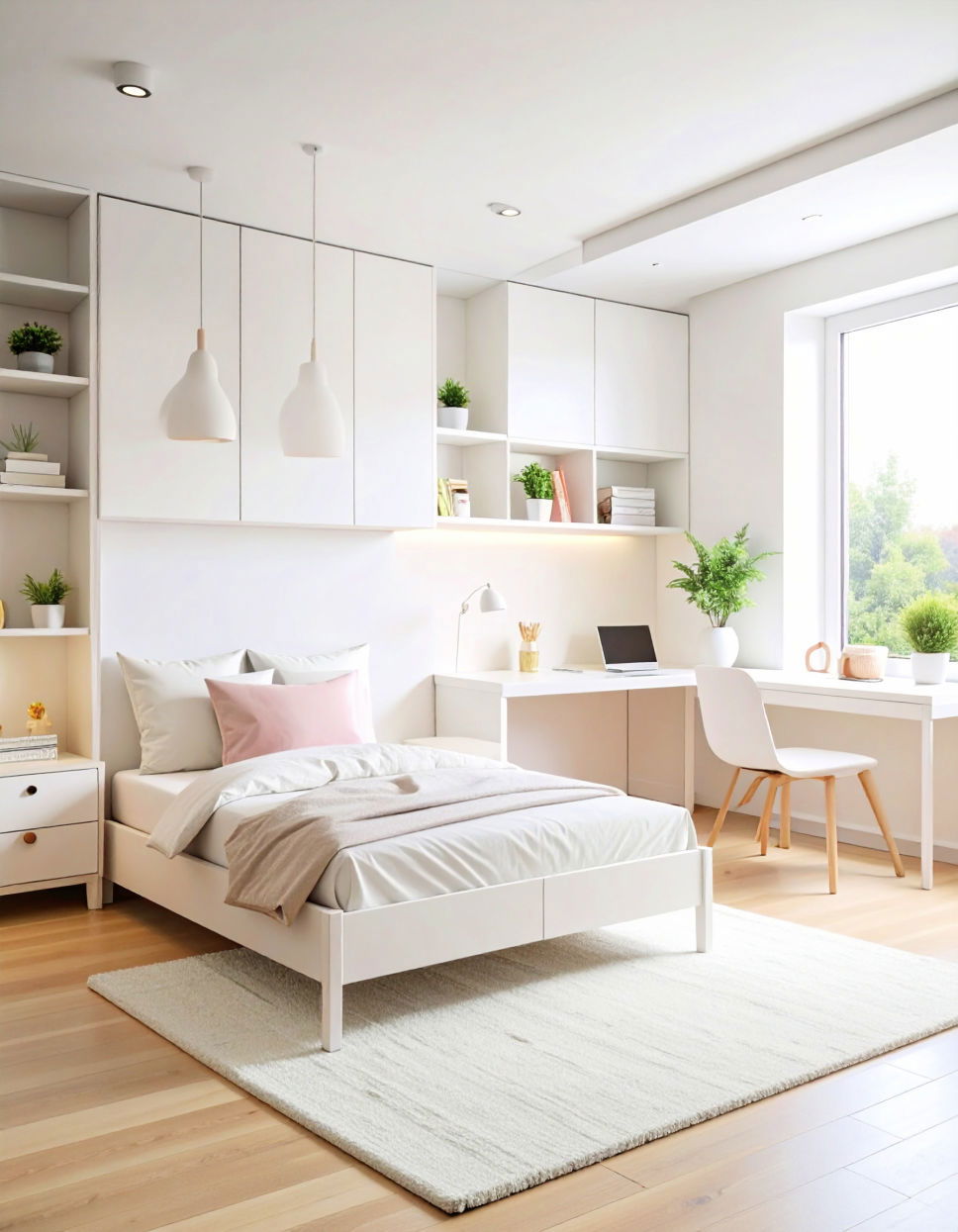
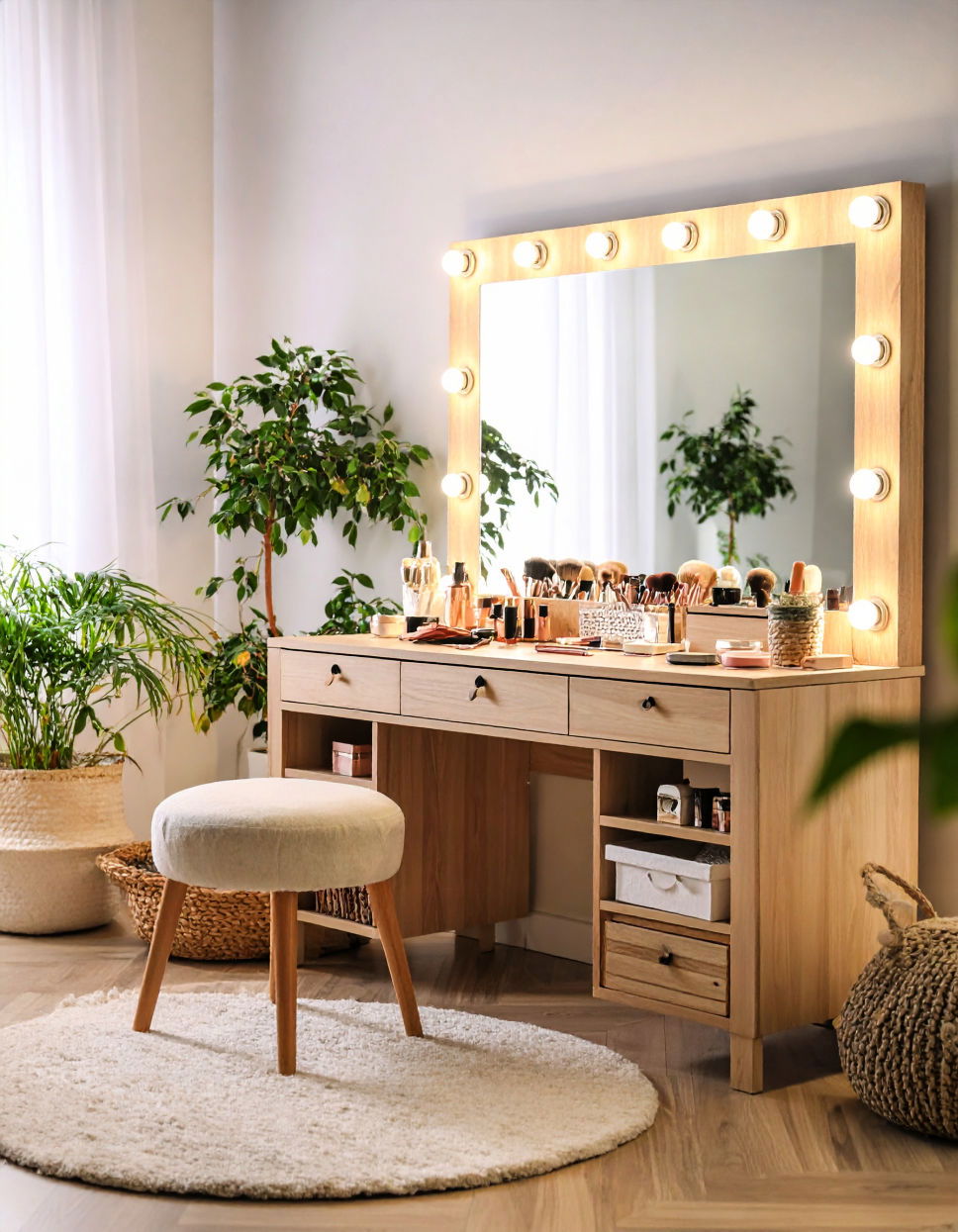
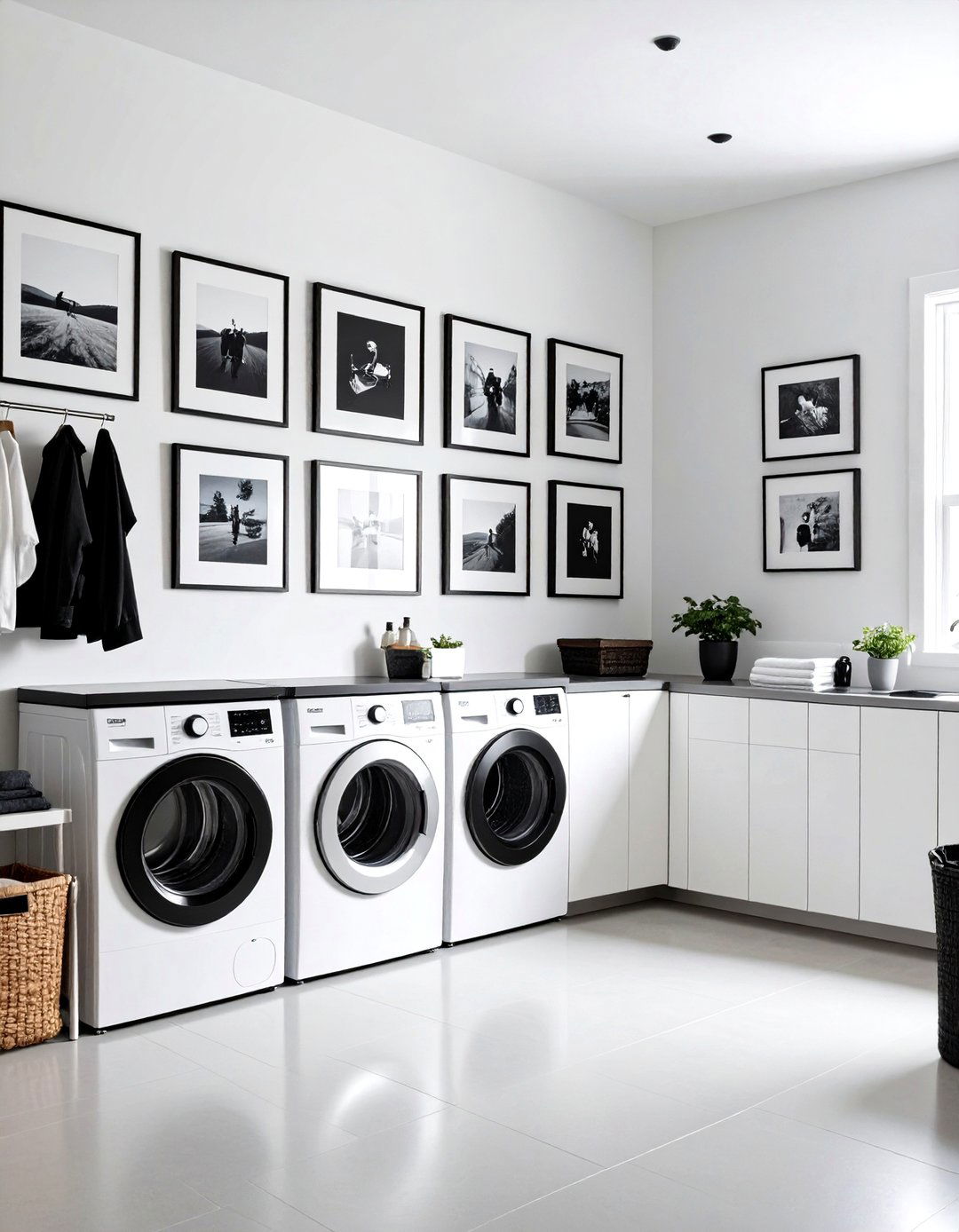
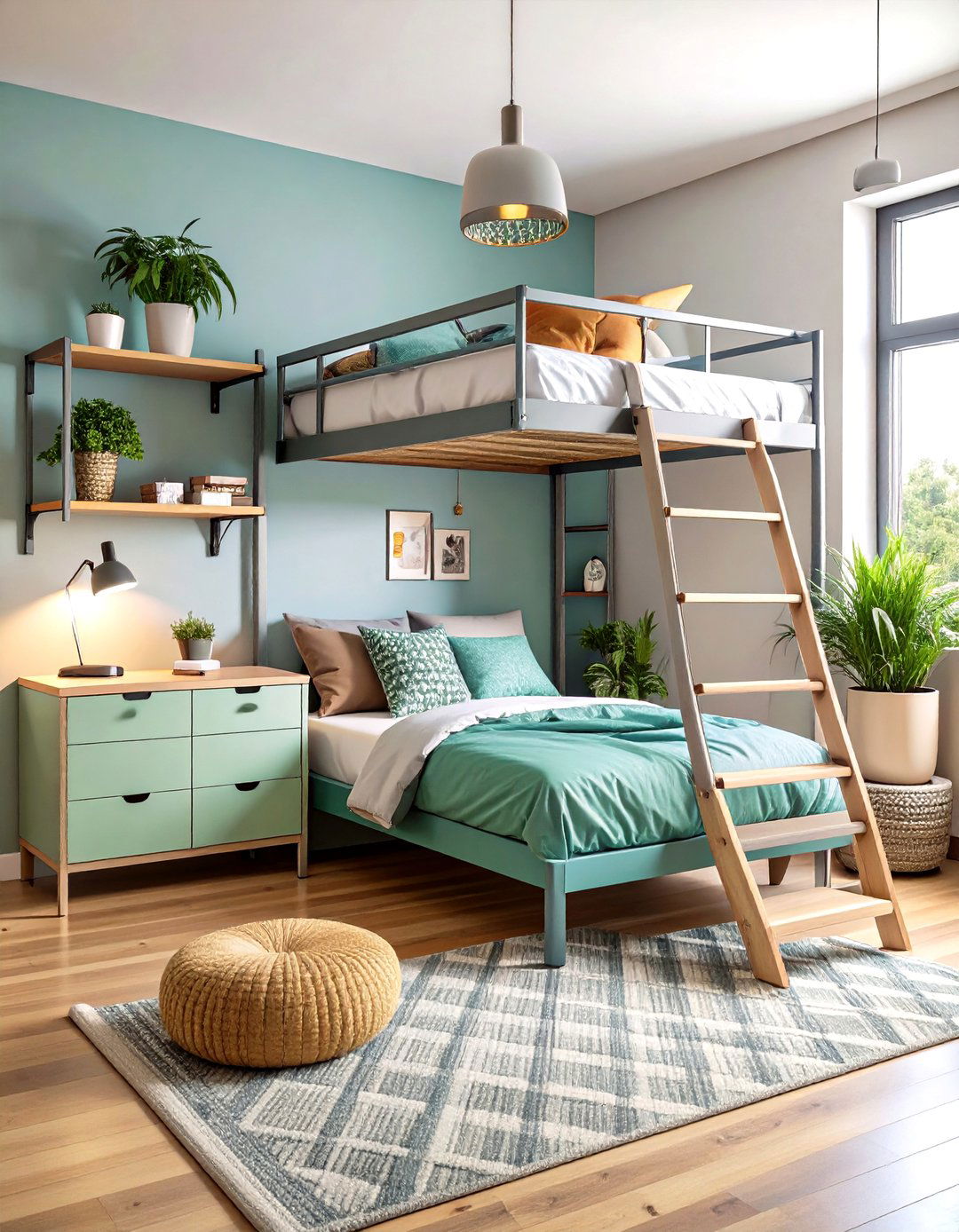
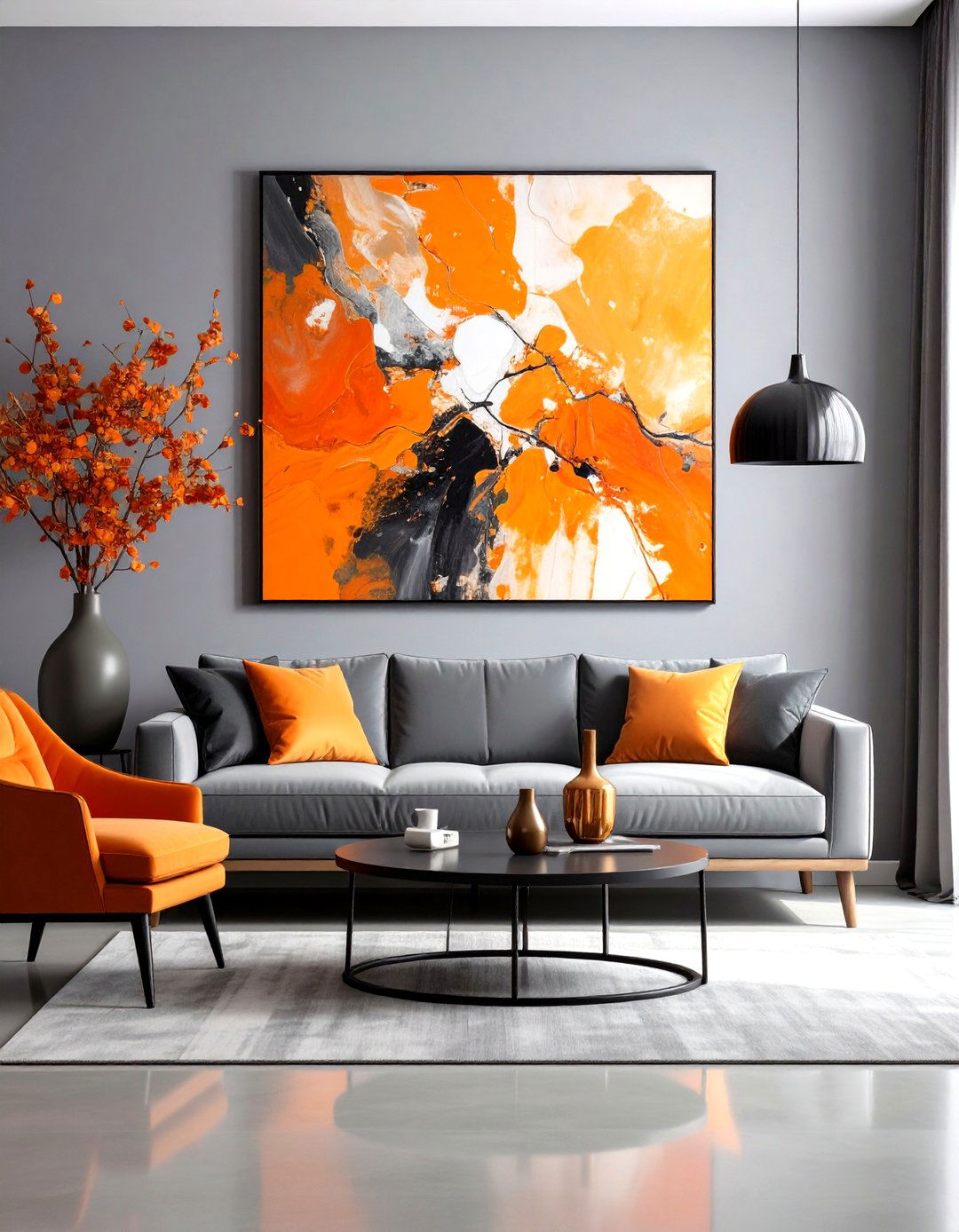
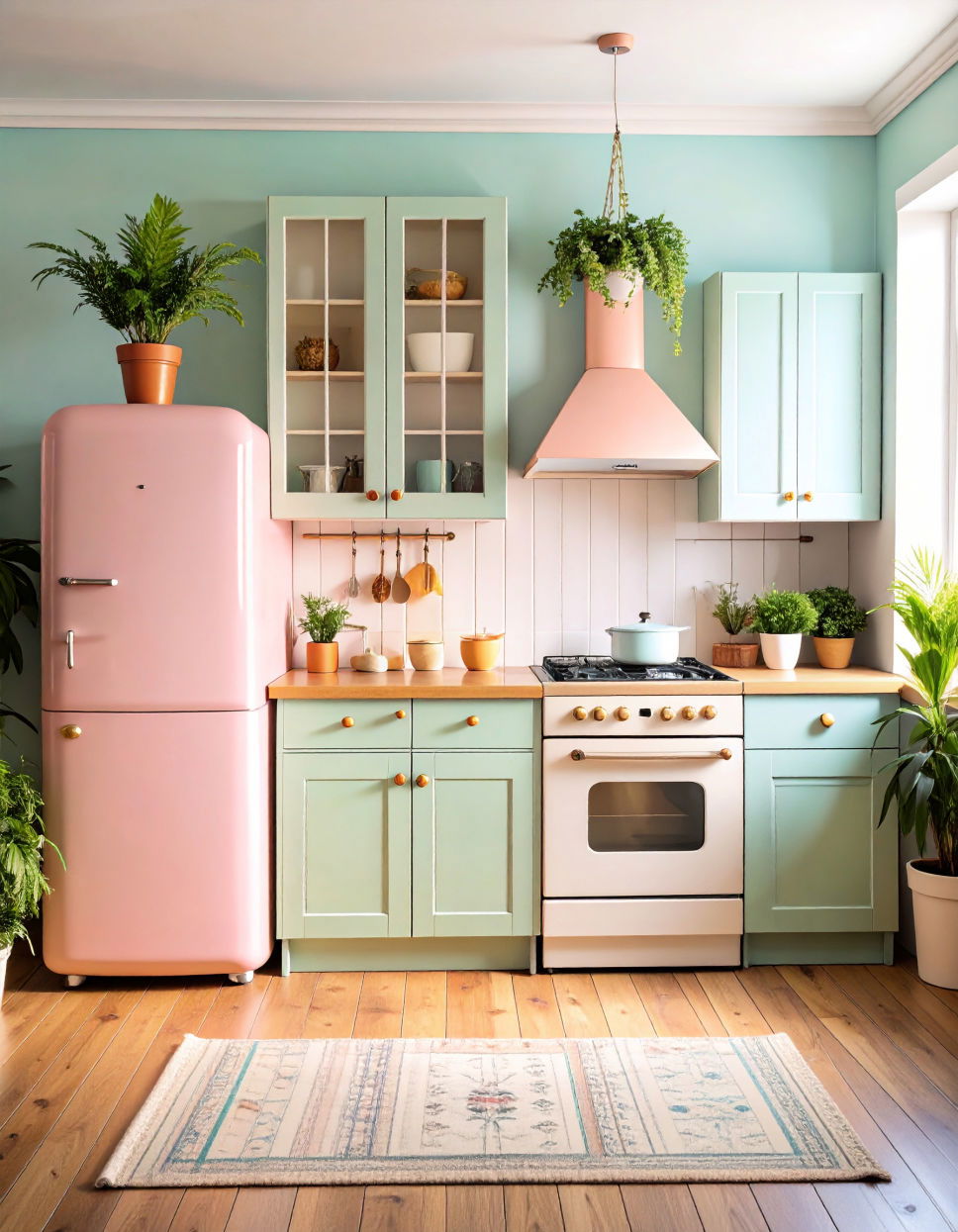
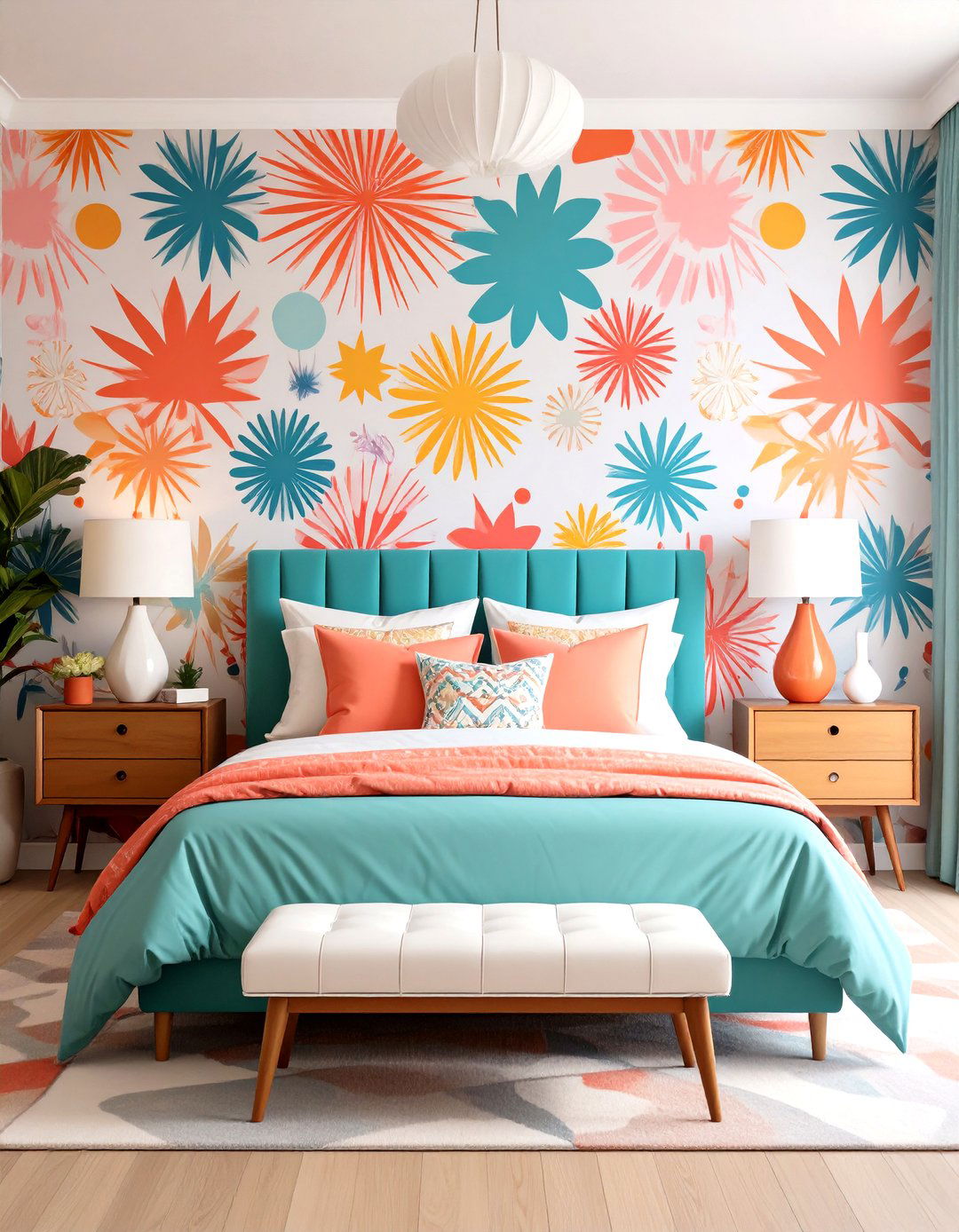
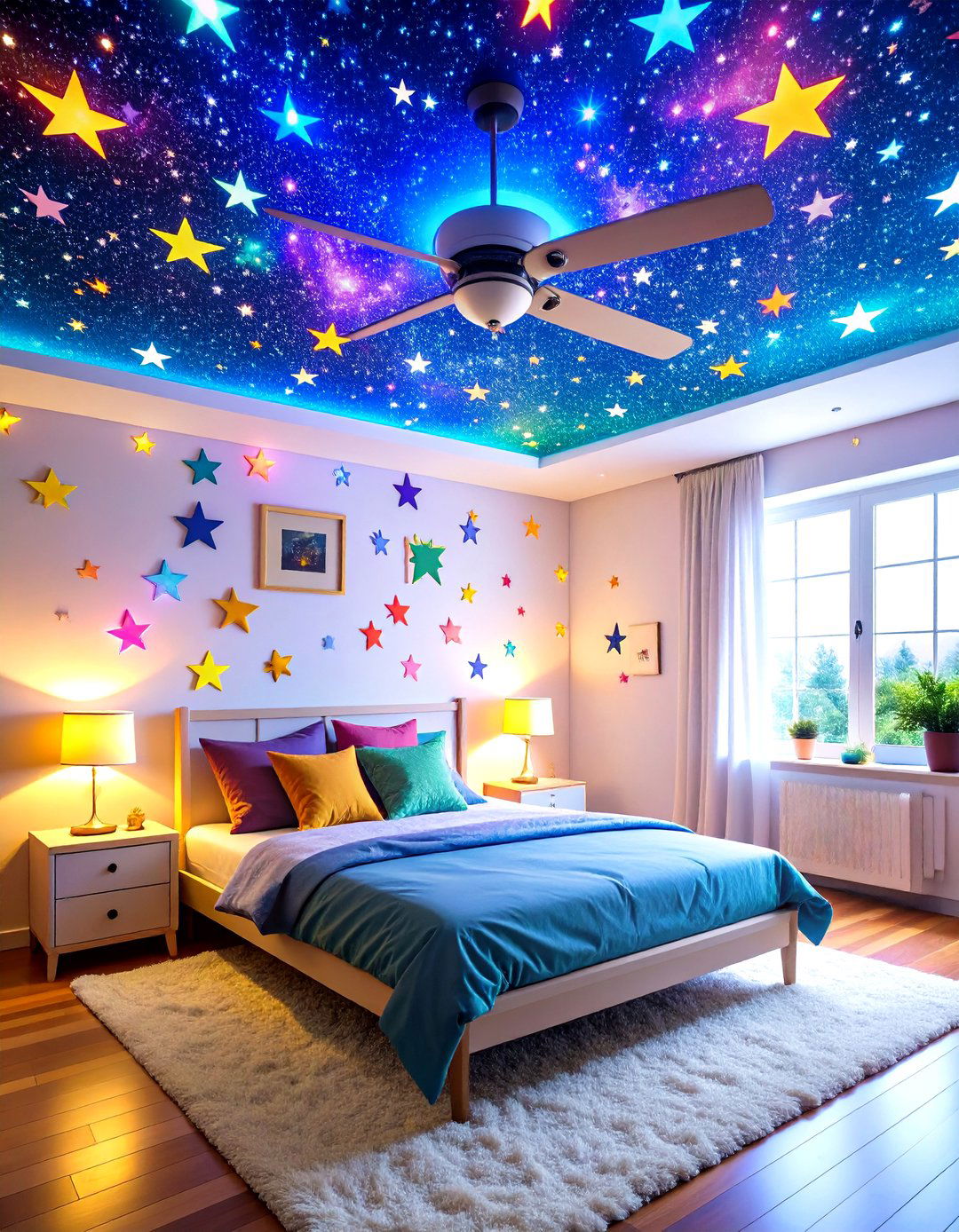
Leave a Reply